#it is fur ! depending on their genes their fur grows more depending on the area
Text
Random Rex info
Rexes are fuzzy !
They have a short but soft fur coat that covers their entire bodies, and has a texture that deflects light in an odd way that makes shadows barely visible, making it so, while facing one, you wouldn't be able to tell where their nose is, or even their mouth if it is closed !
#Rex venandi#Their hair is also not hair#it is fur ! depending on their genes their fur grows more depending on the area#yes that means some Rexes can have manes like lions#or mohawks along their back
5 notes
·
View notes
Note
unsure if people have ask you this but like have tips (or tutorial) for draw grumpuses? /nf
Nope! I've never had anyone ask how I draw grumps ur the first! :3
ill try my best to explain how I draw grumps and some tips, even though I'm not very good at explaining stuff.
But also, fair warning there are headcanons of grumpus biology and other things. :P
But I have...2-3 ways I draw grumpuses, more animalistic or more of a cartoonish way.
But I'd have to say that you'd have to really study the cast we've got in bugsnax, study their body types. Such as with eggabell and my drawing of her.
Her original body shape is eggie, such with her name hehe.

But with more rounder grumpuses (especially more in the stomach and hips area), I've interpreted their round side with fat. In eggabell's body shape you can see how her bottom area is more big than the rest of her body. In the drawing that I made, her body is large in the bottom but makes it way to be thinner just like in her og body. But with more plump grumps they have dewlaps. (Which if I remember properly are made of fat and fur for nesting)
Even with grumpuses like floofty (including other rounder grumps such as snorpy and beffica) >>

In their original yk body and proportions, hips are big, but slowly move up to become thinner. But unlike eggabell they're not yk egg shaped.
But ofc their are....thinner grumpuses, such as wambus or wiggle. Unfortunately I've not drawn them, but I will show my skinnier ocs I've drawn before.
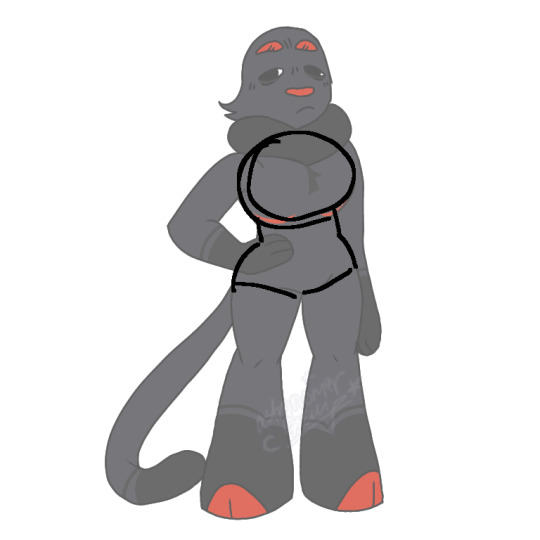

These two grumpuses (even tho they're both undead might I add) have similar proportions as a human would. Mostly with the ratio hips to chest.
But I draw their bodies segmented, say with my skinny grumps you can see how both of their bodies/torsos are made up of three shapes. But with grumpuses like Beffica and Floofty, their bodies are segmented into two main shapes.

But getting into faces and jaw lines...thats always threw me off a bit. But generally speaking I mostly draw faces for grumpuses to be more canine like, either that or to be an animal that more or so fits the characters's.
While I don't really and truly draw much of the actually cast, I fully believe that a character like uh... Say lizbert, if I'm writing this down incorrectly please tell me, but with her I'd imagine she'd more or so look like a seal in the face. A buff seal.
But in general, either more canine or feline like.
With jawlines tho, grumpuses without over/underbites are flat faced. So take that into consideration especially, as their snout would probably point out a bit it wouldn't point out as far as a grumpus with an under/overbite. Say like a pug or smth, they're faces are mostly flat and not as long as dogs with long snouts. Grumpuses with over bites as we all know have teeth that rest above the bottom jaw, causing their teeth/tusks to poke out from their lip. Ditto with underbites, but their bottom jaw goes out more than the top jaw. (Poodles is meant to look like a poodle so that's why her snout points out, BUT I PROMISE THAT'S NOT HOW I USUALLY DRAW IT)



Oh and hair! And eyes as well. Hair, as I assume for grumpuses, can grow on their heads. But it would have to majorly have to deal with genes if a grumpus baby does have hair or fur that grows similarly to fur.
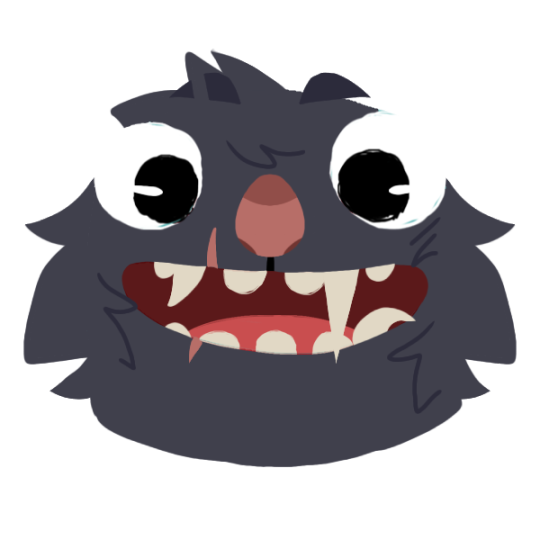

Such as with my two grumpus ocs, one has fur, the other has hair. Again as I've stated, I believe that a grumpus probably needs some type of recessive gene from both parents to successfully grow hair. But it's not really and truly a very rare thing to have. Like I'd assume 45 out of 100 grumps have hair that does differ from long fur.
With eeeyyyeeesss thooo, I imagine it's very similar to what humans have. Such as different eye shapes, sometimes even different patterns of pupils, but that would depend on where the grumpus originates from and how far they we're in the food chain. So yes again, genes. In my own hc I believe grumpuses have 3 different pupils that depend on their gene origin, round pupils (like humans), slit pupils (like cats), and squared pupils (like horses or goats).



We could also get into fur. But again like everything else I've stated before, genes and origins play a huge role in that
But um... For tips, I'd say mostly try and study their anatomy. As well facial structure especially with animals.
As well, take in consideration of characters body shape and anatomy. Even ur own characters.
#bugsnax#art#tutorial#art ref#ref#Tips#art tag#Uuhhh how I draw grumpuses#Kinda#I'm bad at explaining stuff#:(#S#anatomy#bugsnax grumpus#bugsnak#Grumpus biology#headcanon#my headcanons
15 notes
·
View notes
Text
My notes on Strills
Strills are not actually solitary. They used to live in large colonies, with those nursing pups and elders remaining at the den site while other adults and adolescents hunt and forage
The rapid loss of reasources after the Dral Hran lead to colonies splitting up, forcing parents to leave their pups alone to forage and rapidly tanking survival rates
Strill pups are born blind and deaf and completely dependant on their parent. Strills nurse for two weeks and feed their young from a crop for up to a year
Strill pups need three to four years to mature, spending their first year completely at the den site, under the supervision of elders, youngsters and other parents while their own parents are hunting
After that first year, they become more independant, roaming around in bands of agemates and siblings, hunting insects and foraging
With two years and older, young strills acompany the other adults out to hunt and forage.
Strills are actually monogamous! Young strills older than four will either take a mate from a roaming pack of batchelors, find one among fellow batchelors or settle down in a different colony
Strill groups are separated into colonies, a stationary group of couples raising their pups at a shared den site, and packs, roaming groups of bachelors. In some areas, the ecosystem can only support wandering packs
Despite all being genetically close enough to interbreed across the entire planet, due to the high mobility of bachelor packs, strills are extremly dimorphic in their coloring
Or well, they used to be. After the Dral Hran, the pale golden or gray morphs had the best survival chances and thus dominate the planetary gene pool. However, off planet populations still produce other morphs, and you occassionally get differently colored strills on Mandalore as well
The most common coloring is an even base color in pale gold, shades of gray, shades of brown, and reddish brown with a darker ruff of fur. There´s also a melanistic morph that is completely black, a morph that has a silver ruff, rosettes and piebald spotting
Piebald spotting is a gene that unfortunately has high chances of deafness, blindness and other genetic problems. A double piebald is completely white with blue eyes and has very low survival chances. The only instances of double piebald pups surviving to adulthood is in tamed strills raised by people, and they generally have a low quality of life, a hightend chance of brain tumors and don´t grow old
During the current breeding program, piebald strills are neutered and spayed and those pups that present genetical problems are taken out of the to-be-released pool and given to loving homes
Despite currently being the apex predator in every ecosystem on Mandalore, strills are naturally scavangers and small game predators. They´re a keystone species the way hyenas are a keystone species, but currently, no ecosystem can support anything higher up the foodchain in sustainable population sizes
Despite a long time of cooperation, strills are not domesticated. Individuals are tamed and there is captive breeding, but as tame strills are not a different species
Strills are highly cooperative and communicative. They tend to hunt alone or in trios, but at the den site, they are incredibly social
Bachelor packs are actually capable of taking down large game, and do so if they have the opportunity
8 notes
·
View notes
Text
Species Traits and Variants
The two human-descended species of Celantri have signature traits that easily differentiate them from one another, but they also display variance within their own species as a result of adapting to various climates. Though notable gene pools are listed, the variants are very intermixed on modern Celantri. Most individuals carry traits associated with multiple variants, even if one appears more dominant.
AWANI TRAITS
Skin - Shades of beige and brown. Similar to human skintones, but often a bit more greyed. Their blood is wine red.
Hair - Can be any color (usually on the muted side), but black is most common. Always a different color than frills. All Awani have hair on their head, armpits, and pubic area. Most have a tuft of fur on the chest. May or may not have body and facial hair depending on subtype and scale distribution. Some may have short, fine hair on the tail (see below).
Scales - Three scale types are most common - smooth, coarse, and fine. Smooth scales are rounded and evenly spaced. They are usually semitransparent. Coarse scales are opaque, diamond-shaped, and grow in clusters. Fine scales are very small, giving a gradient-like effect as they fade into the skin. Scales are most often the same color as frills, but not always.
Tail - Thick tails are better for storing fat and floating in the water, while thin tails are better for agility. The body of the tail may be bare (skin color), fully or partially scaled, or covered in a fine, velvety hair. Frills grow near the tip of the tail, and may continue upwards all the way to the base. A rare gene also exists that causes the end of the tail to grow spikes rather than frills. They can drop their tail under extreme stress, though this will lead to discomfort and balance problems afterwards. It will take anywhere from 6 months to a year to completely grow back.
Eyes - Iris/pupil shapes and colors vary widely - the evolutionary significance of this is unclear.
Hands/Feet - Awani have clawed fingers and toes, with the knuckles typically reinforced by thick scales. Heavy scaling on the hands is a fairly common trait, as are hard, stiff "fully clawed" toes. They often have durable pads on the underside of the feet, and, less commonly, on the palms of their hands. Some individuals may have 4 fingers or toes per appendage instead of 5.
Teeth - They may have any combination of sharp and flat teeth, but will always have at least one set of visible fangs. Some may have a full mouth of sharp teeth. Some fangs will continue to grow with age - older Awani are more likely to have teeth that stick out even while their mouth is closed
Ears - Ears come in various shapes and lengths, usually with one or two points to them. They may have frills surrouding them entirely, or only on the top or bottom.
Frills - As mentioned above, frills always grow around the ears and tail. They may also grow between extremities, on lower limbs, and/or the torso.
Whiskers - Awani have 1-3 sets of thick, flexible whiskers that grow between the mouth and the jawline, made of the same material as their frills. These whiskers allow them to sense changes in barometric pressure and wind currents. Individuals have varying whisker lengths and growth patterns. They can comfortably be trimmed down to a smaller base, but will always grow back to their full length.
VARIANT CLASSIFICATIONS
Primordial – The “original” Awani that the other variants later descended from. Typically pictured as heavily scaled with smooth scales, large fangs, long whiskers, and black hair and tails. Common in Kalibaru and Auvedaya.
Coastal – A variant most suited to living around the water. They have fine scales, very little body hair, more frills, and large, thick tails. Common in the Spiral Isles and Auvedaya.
Arid – Adapted to harsher desert conditions. They usually have coarse scales, longer ears, slitted pupils, and thin, flexible tails – they are the carriers of the spiked tail gene. Most likely to have 4 digit hands/feet. Common in Ishanyr.
Continental – Compared to the other variants, these Awani are better suited to colder conditions. They are prone to more body hair, short whiskers (but multiple pairs), coarse scales, fully sharp teeth, light hair, and short, thick tails. Common in Ishanyr.
GUNARI TRAITS
Skin - Dull tones of purple, blue, or red. Their blood is a deep indigo.
Hair - Can be any color, but never the same color as the antennae. They tend to have more body hair. There may be tufts of hair around the wrists, ankles and tail, and/or in or around the ears. How far up the appendage this thick tuft of hair grows depends on the variant.
Ears - Large folded ears. May stick out straight (the most common), swoop back, flop down, or even point upwards like a cat. Some are more rounded, while others are more pointed. The outer part of the ear is a different color, while the inner part matches the rest of their skin. Usually has only one point, but may have several. Ear size and range of movement vary. Those with more reactive ears will show their emotions more easily.
Antennae - Antennae come in various shapes and sizes. They may be fluffy, bare, or have a thin growth similar to an insect’s wing.
Markings - Some Gunari carry a recessive trait that causes them to have skin markings in the same color as their antennae - these may appear like freckles, splotches, or stripes.
Tails - The Gunari have long, thin tails topped with an appendage similar to their antennae. The shaft of the tail is the same color as their outer ears.
Hands/Feet - Rounded fingers and toes with nails but no claws. Their hands and feet have gecko-like properties that allow them to easily climb up vertical surfaces.
Eyes - Round iris/pupil, any color. Those that evolved the deepest underground may have full-colored eyes. All variants have some degree of night vision
Teeth - Flat teeth.
VARIANT CLASSIFICATIONS
Forest – The first group of Gunari to settle on the surface. They usually have long, fluffy antennae and small tufts of fur on the tail, wrists, and ankles. Their ears generally stick out straight with a pointed tip and are very reactive. They are the most likely to have skin markings, which may have served as a sort of camouflage. Common in North and South Florene and Ishanyr; the most common variant overall.
Tropics – Gunari adapted to a warmer environment. They have the largest ears on average, which are usually rounded and floppy. Their long antennae usually have the thin “insect wing” growth on the ends. Of the Gunari variants, they are the least hairy. Instead of hair, their tails will have the same membrane on them as the antennae, which is often iridescent and considered quite beautiful. Common in South Florene.
Tundra – Adapted to the coldest environment; this variant spreads further north than any other group on the planet. More hair, including inside the ears and all the way down the tail. Ears are shorter and usually point up. Short, thick, fluffy antennae. Common in North Florene.
Deep – More alien in appearance than the other variants. Their hair covers much of their body but remains quite short. Their pupils are large enough as to fill the entire eye, and their antennae are long and bare. The ears have multiple points and stretch backwards around the head. Uniquely, the do not have a defined nose, only nostril slits. As they live deep underground on North and South Florene, they are rarely seen on the surface, much less across the sea.
#worldbuilding#original species#original characters#fantasy#fantasy worldbuilding#writing#writer#didnt even talk about awani-gunari hybrids here. they are possible but rare.
7 notes
·
View notes
Text
I'm really sorry everyone for the previous post, here is a new version with hopefully two different options!
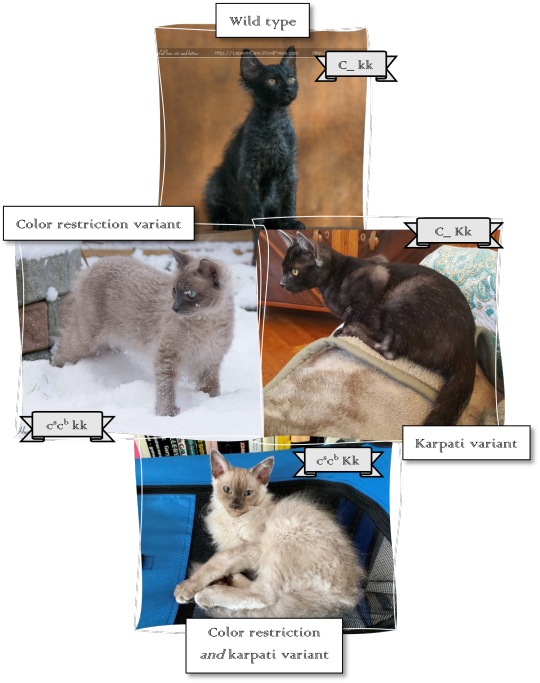
Featured breed: laperm
Yeah, the last cat really is a pointed karpati! (Well, it's a mink.) Note the white ears and lightly colored legs and tail, both of which is unusual for a standard colorpoint cat.
genetics guide
Color restriction (tyrosinase, TYR): Mutations on this gene will result in temperature-sensitivity in the pigment production, the cats will be lighter on the warm and darker on the cooler areas of their bodies.
dominant allele: C - regular pigment production, full colored cat (wild type)
allele: cb - moderately reduced pigment production: burmese color restriction, sepia cat (variant)
allele: cm - reduced pigment production, bangkok color restriction, mocha cat (variant)
allele: cs - highly reduced pigment production: siamese color restriction, pointed cat (variant)
recessive allele: c - no pigment production, albino cat (variant)
Order of dominance: C > cb = cm = cs > c
For the sake of aesthetics, the only variant allele I depicted is the rarest cm.
further destription in this post
Karpati (?): This unidentified gene makes the extremeties (face, ears, legs, tail) white kinda like a reverse colorpoint cat, and causes a roaning effect: scatters white hairs everywhere on the body.
dominant allele: K - whited extremities, karpati cat (variant)
recessive alleles: k - normal pigmant production, full colored cat (wild type)
further information in this post
Bonus: Temperature sensitivity
I've mentioned previously that colorpoint and karpati kinda looks like each other's inverse.

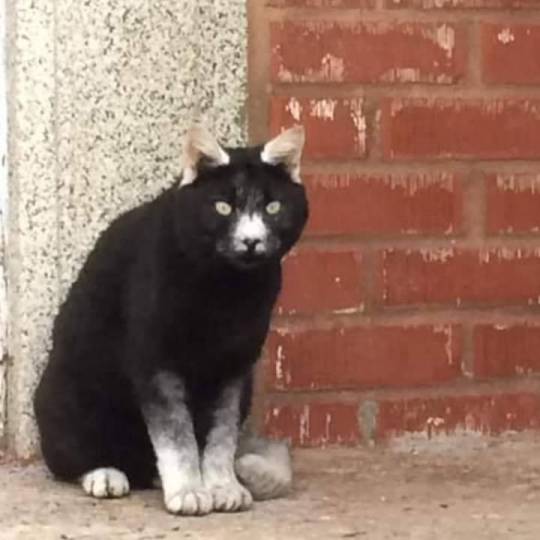
(This cat has a very good karpati effect, most of them has lot less white on their nose and around their muzzle - most likely it's a quite old one.)
Do you know what connects the body parts that are dark on a pointed and light on a karpati cat?
Well, look at this image:

It's an infrared photo; it shows the heat emission from the cat. (Well, if it's real. But even if this particular illustration is computer-made, the phenomenon it shows is real.) You can see that the legs, the tail, the face and the ears are the coldest areas.
The pigment production in colorpoint and presumably karpati cats is heat-associated: it's efficiancy declines or rises with the temperature.
Before they born, the kittens bath in the even warm of the womb, so first they're even colored: white for a colorpoint and almost full black (or the respective color) for a (hezerozygous) karpati.
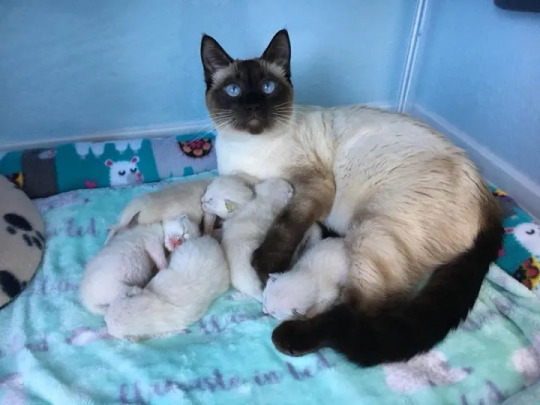
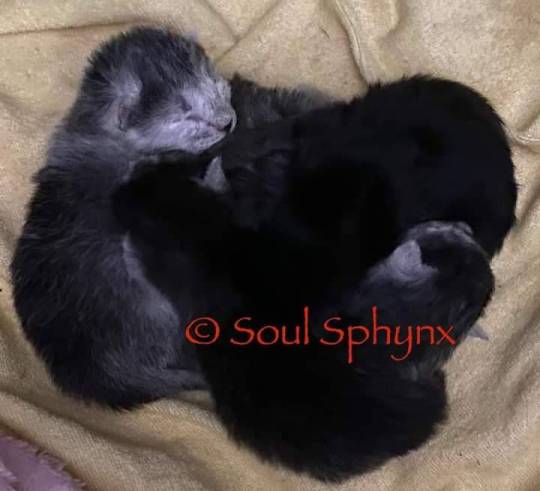
An all colorpoint litter and a karpati litter with one(!) non-karpati. Look for the white ears!
After a few weeks, their colors are already much more developped:

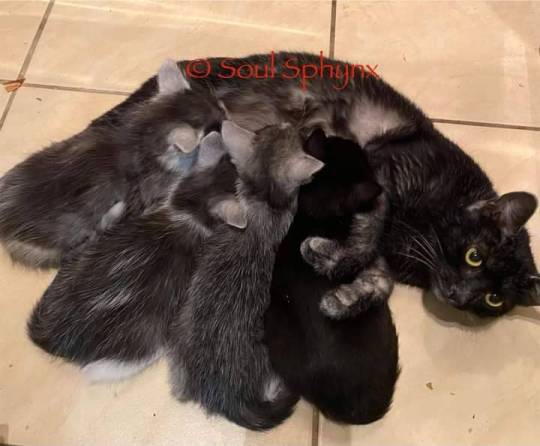
(Same litters as above)
Oké, actually we don't really know how karpati works. Some heat sensitivity is very likely, but the cats' color changes during their lives definitely don't depend only on the temperature, since these very spectacular kittenhood patterns quickly fade away and then comes back slowly and very differently depending on individual. (Again, this is only true for heterozygotes. Homozygotes don't lose all their whiteness.)
The temperature sensitivity can result in really funny patterns in colorpoint cats: if a cat loses some of its fur for some reason, and later it grows back, it'll be noticeably darker then the surrounding area, because the naked skin means the temperature is lower there.

This cat from messybeast had a leg injury that needed surgery, so now he wears pants until the next molt.
#polls#cats#cat genetics#macska#genetics#tournament poll#round 3#color restriction#karpati#cat color gene tournament
27 notes
·
View notes
Text
Blorbos
Blorbos are a species i thought of late at night.
They are little creatures with many different forms
There is the normal Blorbo
The fluffy blorbo
The fairy Blorbo
The taily blorbo
And the aqua blorbo
The taily blorbo is close cousins with the fluffy blorbo. But make no mistake, they don't really get along that well. No one knows why yet.
The fairy blorbo is the only blorbo that has some sort of magic. Its only telekenises but its still a power none the less. Like all Blorbos, the fairy blorbo comes in many colors, they tend to be soft pastels or bold and bright. Fairy blorbos tend to be very showy. Their wings come in a variety, from butterfly wings to dragonfly wings. They can also have feathered wings but thats less common, and usually a result if a Fluffy blorbo and a Fairy blorbo.
All blorbos have a round body with thin legs. Normal blorbos tend to bounce to get from one place to another.
Depending on the blorbo, it will determine what they look like. Taily Blorbos have fluffy round bodies like Fluffy blorbos, but they have a tail in the back that is prehensile. Since the fairy blorbo is the only blorbo with arms, this comes in handy. Fairy and Normal blorbos have smooth round bodies, but a normal blorbo has more stretchy skin then a fairy blorbo as it bounces a lot. Fairy blorbos have soft smooth skin akin to a humans. Aqua blorbos have scales and two fins on the sides of their faces and webed feet to help them glide through water. They have lungs but its healthier for them to be in water so some Aqua Blorbos will wear a water helmet. Fluffy blorbos have very soft fur and delicate skin. The fur is dense and helps protect their skin, with Taily blorbos, their fur is more silky then fluffy, they have tougher skin then fluffy blorbos
Fairy blorbos tend to come with one or two sets of arms, but if a Fairy blorbo and a taily blorbo were to have a child, that child would have a mix and match of attributes, like if they had a fluffy body with wings and a set of arms. It can vary depending on who has stronger genes
Blorbos reproduce via weird stuff. Basically if they wabt to have a kid together, they find a blorbo flower. They bloom in secluded areas but they are locally grown in blorobo villages. When they get the blorbo flower, they put a part of them in the flower. Out pops two seeds, a read one and a blue one. The red one is the one they plant for a kid, and the blue one is the one they give back to the flower farmer to keep the chain of blorbo flowers going. They plant the seed and wait 9 days and then the flower sprouts out and blooms, out pops a Blorblet from the bloom.
Blorbo flowers can grow anywhere in any condition, and truely the only blorbo that can retrieve these flowers are the ones that pollinate them. This is not an uncommon job for Fairy blorbos. Not all fairy blorbos pollinate for work but a nice portion dose. Helps keep the population of blorbos alive
Whe it comes to clothing, Blorbos tend to wear bottoms since they don't have arms to take off tops. With the exception of Fairy and Taily blorbos. The clothing is loose and easy to move around in since they use their legs all the time and some blorbos have delicate skin or extra limbs like the Fluffy blorbos, Taily blorbo and the Fairy blorbo. Some blorbos wear hats on their heads to events like weaddings or parties or to protect themselves from the sun. Fairy blorbos and Taily blorbos tend to have an easier time when it comes to clothing since they have arms/tails. Fairy blorbos tend to wear clothing that contrast their natral color very well. Scarfs, bandanas, and loose zip up hoddies are an a okay for all blorbos, But depending on if the blorbo is a Fairy or a Taily, you might want to refrain from putting a banddana on a blorbo with no arms. Taily blorbos tend to wear bandanas and loose shorts or pants with a hole in the back for their tail. Loose and comfy is the style that all blorbos go for
Normal blorbos when they sleep, they tend to sleep all huddled up together. So its very normal to see a Normal blorbos sleeping sorounded by stuffies if they live alone. Same with normal blorblets
Fluffy blorbos sleep in piles together, but if a Fluffy blorbo lives alone, they don't mind sleeping in a bed one bit.
Aqua blorbos actually float when they sleep. So dont be surprised if you see a scaley blorbo's face sticking out of the water. They don't luke to sleep in their houses for this very reason, But aqua blorblets do, since they haven't learned to swim and they dont have that air bubble in thair body to make them float in the water yet, so they have no issues with sleeping in their houses
Taily blorbos sleep upside down useing thsir tails. They do this for naps or long sleeps. They have bars in their rooms with a bed underneath, so that if they slip and fall on accident they wont be hurt. This is usually for young Blorblets and older blorbos or taily blorbos who have bad tail contorol
And Fairy blorbos sleep in little beds in their houses. They don't sleeo with someone else unless married or in a relationship. They are simple blorbos with simple blorbo needs.
Blorblets dont have much difference from adult blorbos, but they are a bit paler in color and it brightens as they get older.
When blorbos want to get married, they do it penguin style. They find a rock, not just any rock, a rock that they know their partner would say yes too since the rock reminded them of themselves. A lot of detail goes into the rock. They will get it engeaved with their partners name and then present the rock. If they like it, they get married. And to show two blorbos are married, they wear silicone rings on their ankels that match their partners color.
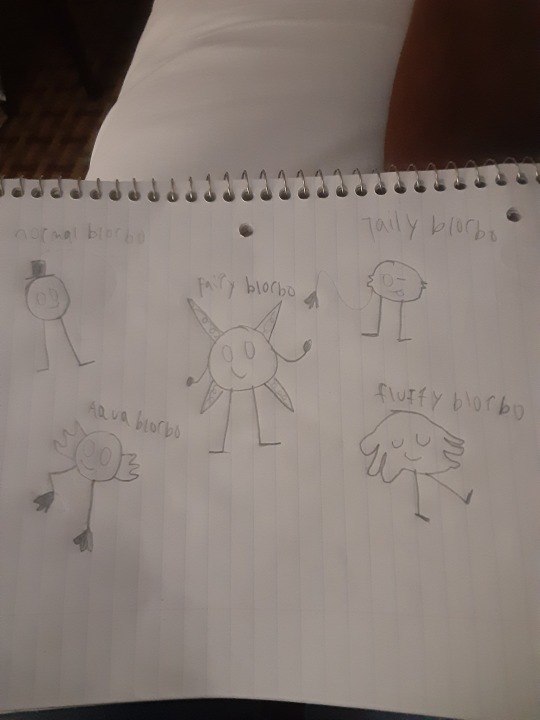
3 notes
·
View notes
Text
Black Syrian Hamster & 20 Facts You May Want To Know
Find out everything you need to know about Black Syrian Hamsters, from how they look and act to what they eat and where they live. Read on to learn more about these cute pets.
How do you define Black Syrian Hamster?
The Black Syrian Hamster is a type of hamster that is kept as a pet and is known for having black fur. They are like other breeds of Syrian hamsters in many ways, but they have a dark coat that makes them stand out.
People like to keep these hamsters as pets because they are friendly and don't need much care. They usually get about 6-7 inches long and can live up to three years if they are cared for well.
Where and when did the Black Syrian Hamster come from?
The Black Syrian Hamster, which is also called the Golden Hamster, comes from Syria's dry areas. They were first found in the late 1700s, and in the 1930s, scientists brought them to the United States to study them.
Because they were friendly, easy to care for, and cute, these hamsters quickly became popular as pets. They are one of the most common types of hamsters kept as pets today.
What the Black Syrian Hamster looks like
The Black Syrian Hamster, which is also called the Golden Hamster, is a small mammal that grows to be about 6-7 inches long. As the name suggests, their fur is shiny and black, and some of them have white bellies. They have big, dark eyes, and their ears aren't very long. Their front paws have four toes and their back paws have five.
The body of a black Syrian hamster is stocky, and it has a short, furry tail. They are known for being social and friendly, which makes them popular pets. Overall, they are easy to tell apart from other kinds of hamsters because of the way they look.
Where and how the Black Syrian Hamster lives in nature
The black Syrian hamster is a small animal that lives in the deserts of northern Syria and southern Turkey. Its scientific name is Mesocricetus auratus. It lives in dry, rocky areas with sandy soil and little plant life in its natural habitat.
In the wild, black Syrian hamsters are burrowing animals that make complex tunnel systems to live in and store food. They are used to living in hot, dry places and can go for long periods without water because they get water from their food.
As pets, black Syrian hamsters need large cages or enclosures that look like their natural habitat. They also need clean water and a varied diet that includes fresh vegetables, fruits, and high-quality commercial hamster food.
How a Syrian hamster acts and how it acts
Syrian hamsters, which are also called "Golden Hamsters," usually live alone and can be very territorial. They are most active at night and may do things like dig holes and run on exercise wheels at night.
Syrian hamsters have different personalities, and if you socialize them well, you may be able to handle them. But they may also act aggressively toward people of the same gender or people they don't know.
To keep from hurting them, you should be gentle and careful when you approach and handle them. Overall, giving Syrian Hamsters a comfortable and interesting place to live can help improve their behavior and health.
Black Syrian Hamster Size?
The Black Syrian Hamster, which is also called the Golden Hamster, can grow to be about 6-7 inches (15-18 cm) long and weigh about 4-5 ounces (113-142 g). But there can be some difference in size depending on things like genes, diet, and where they live.
Care for a Black Syrian Hamster
People like to keep black Syrian hamsters as pets because they look cute and cuddly, like teddy bears. Here are some suggestions on how to take care of a Black Syrian hamster:
Hamsters need a lot of room to move around in their homes. There should be at least 360 square inches of floor space. Ideal is a wire cage with a solid bottom.
Bedding: Use bedding that won't hurt your pet, like paper or aspen shavings. Don't give your hamster pine or cedar shavings, which can hurt them.
Food: Give your hamster a well-balanced diet of high-quality hamster pellets, fresh vegetables, and treats like fruit or seeds every once in a while. Make sure that you always have a sipper bottle with fresh water.
Hamsters need to get out of their cages and run around every day. Give them a hamster ball or a safe place to play where they can be watched.
Grooming: Black Syrian hamsters have long hair that needs to be brushed regularly to keep it from getting tangled or matted. Gently brush or comb your hamster with a soft brush or comb.
Health: Have a vet who specializes in small animals check on your pet regularly. Look out for signs of illness, like being tired, not wanting to eat, or having trouble breathing.
By taking care of your Black Syrian hamster in these ways, you can make sure it stays healthy, happy, and comfortable in its home.
Health Problems Often Seen in Black Syrian Hamsters
Black Syrian Hamsters often have problems with their teeth, respiratory infections, and wet tail disease. Overgrown teeth can cause dental problems, which can make it hard to eat and require help from a vet. Poor living conditions, like not enough air flow or too much humidity, can cause respiratory infections.
Wet tail disease is a bacterial infection that can lead to severe diarrhea, dehydration, and death. Regular visits to the vet, a good diet, and good hygiene can help keep these health problems from happening.
How to feed a Black Syrian Hamster and what it needs to eat
As with all hamsters, the Black Syrian hamster needs a balanced diet to stay healthy. The best diet for a hamster should include a high-quality commercial hamster food and a small amount of fresh fruits and vegetables. Sugary or fatty foods should be avoided because they can cause obesity and other health problems.
Hamsters also need to always have access to clean water, which should be changed every day. Your Black Syrian hamster can also stay healthy and happy if you give it toys, tunnels, and exercise wheels so it can get some exercise and keep its mind active.
Setting up a home and a cage for a Black Syrian Hamster
It's important to give a black Syrian hamster a cage that is at least 80cm by 50cm in size. The cage should have several levels that are connected by ramps or ladders, and it should be lined with something like aspen shavings or paper-based bedding.
To keep your hamster from getting bored, give it things to chew on and places to hide, like tubes or boxes. A running wheel is also important for exercise, and you should choose one with a diameter of at least 20 cm.
Make sure the cage is in a safe, quiet place in your home, away from drafts and direct sunlight. Give them food and water every day, and clean the cage thoroughly once a week to keep it clean.
Overall, your black Syrian hamster will live a happy and healthy life if its cage is well-designed, well-kept, and has a lot of things to do.
Breeding and Reproduction of Syrian Hamsters
Syrian hamsters can have babies at any time of the year. Females reach sexual maturity at about 4 to 6 weeks, while males do so at about 8 to 12 weeks. But they should not be allowed to mate until they are at least 3–4 months old.
When breeding Syrian hamsters, it's important to make sure the male and female are put together in a neutral area and closely watched as they mate. Due to the risks of pregnancy and birth complications, female hamsters should not be bred after they are 9 to 10 months old.
Syrian hamsters are pregnant for about 16 to 18 days, and their litters usually have 4 to 12 babies. After having their babies, female hamsters will take care of them on their own, so it's best not to bother them during this time. Young hamsters can be weaned from their mothers when they are 3–4 weeks old, and the males and females should be kept apart to stop them from having babies.
Overall, when breeding Syrian hamsters, both the parents and the babies need to be cared for and watched closely to make sure their health and safety.
How to Groom and Take Care of a Black Syrian Hamster
Black Syrian Hamsters need to be groomed and cared for in a few important ways that are important for their health and well-being as a whole. Here are a few pointers:
Black Syrian Hamsters have long hair that needs to be brushed often to keep it from getting tangled or matted. You can care for their fur with a soft-bristled brush or a fine-toothed comb.
Bathing: Black Syrian Hamsters don't need to be bathed often because they clean themselves often. But if your hamster gets dirty, you can give it a shallow bath with lukewarm water and a mild shampoo made just for small animals. Make sure to wash the hamster well and let it dry completely before putting it back in its cage.
Black Syrian Hamsters' nails can get long and sharp, which can be painful and even hurt the animal. Use small animal nail clippers to cut their nails regularly so they stay at a healthy length.
Care for their teeth: Black Syrian Hamsters' teeth grow their whole lives, so giving them lots of chew toys and hard treats can help keep their teeth healthy and stop them from getting too long.
Cleaning the cage: Clean your hamster's cage often to make sure it stays clean and healthy. Every day, get rid of any dirty bedding, food scraps, and waste, and change the bedding once a week.
By taking care of your Black Syrian Hamster like this, you can help keep it healthy, comfortable, and happy.
How long a Black Syrian Hamster lives
Most Black Syrian Hamsters live between 2 and 3 years, but some can live up to 4 years if they are well taken care of.
How many kinds of Black Syrian Hamsters are there?
There is only one kind of Black Syrian Hamster. They are a breed of domesticated hamsters that are known, among other things, for having black fur. Black Syrian Hamsters are sometimes called Golden Hamsters or Teddy Bear Hamsters, but these are just different names for the same breed.
Pets that are Black Syrian Hamsters
The Black Syrian Hamster, which is also called the Golden Hamster, is a popular pet because it looks cute and is easy to take care of. They are friendly, social animals that are easy to tame by handling and interacting with them often. Black Syrian Hamsters need a cage with a lot of room to run around, bedding that gets changed often, and hamster food with fresh fruits and vegetables added to it.
They live for about two to three years and need to go to the vet often. Overall, Black Syrian Hamsters can make great pets for people who are responsible and willing to take care of them properly.
How They Get Along with Other Pets and People
Animals learn how to get along with other animals and people through their interactions with them. Proper socialization is important for a pet's good behavior, ability to communicate, and emotional health. It can help stop people from being angry, anxious, or scared.
Playtime, bonding activities, and training sessions are all good ways for people and pets to interact. But pets can have bad behavior and emotional problems if they are treated badly, like by being hit or ignored.
It's important to watch and control how people and pets interact, especially with children, to keep everyone safe and build a good relationship.
How to train and take care of a Black Syrian Hamster
Black Syrian hamsters need to be trained and handled with patience, consistency, and positive reinforcement. You can tame a hamster by giving it small amounts of food and letting it get used to your presence and smell.
Gradually spend more time with the hamster by holding it and gently petting it. Be careful not to startle or scare the animal.
It is important to give the hamster a safe and comfortable home with lots of toys and places to hide. You can build trust with your hamster by handling it often and letting it meet new people. This can lead to a happy and healthy relationship.
Black Syrian Hamster Differences Between the Sexes
Male and female Black Syrian hamsters are different in many ways, including how they look and act. Most of the time, males are bigger than females, and their tails are longer and thicker, with a bulge at the base. They also have testicles that can be seen right next to their anus.
Male Black Syrian hamsters may be more territorial and aggressive, especially toward other males. Females, on the other hand, are more social and can be kept in pairs or groups.
Females also have a four-day period called "heat" that is part of their reproductive cycle. This can temporarily make them more active and loud.
When choosing a Black Syrian hamster as a pet and taking care of it, it's important to know about these differences between the sexes.
Black Syrian hamsters come in different types and colors.
There are a lot of different kinds and colors of black Syrian hamsters. Here are some common ones:
Standard Black: This is the most common type of black Syrian hamster. It has shiny black fur and is the most common color.
Satin Black: The hair on these hamsters is a little bit longer and shiner than on regular black hamsters.
Black-Eyed White: Their name sounds like they are white, but their fur is white and their eyes are black.
Dominant Spot Black: These hamsters have black fur with a few white spots.
Banded Black: The fur on these hamsters is black, and there is a white band around their middle.
Albino Black: These hamsters have black fur, but their eyes are pink or red because they lack pigment.
Even though black is a common color for Syrian hamsters, there are a lot of different shades of black that can make each hamster look different.
Compare the Black Syrian Hamster to other types of hamsters.
The Black Syrian Hamster, which is also called the Golden Hamster, is bigger and calmer than many other types of hamsters. Their black fur is another thing that makes them stand out. Black Syrian Hamsters may be easier to handle than other breeds like the Dwarf Hamster or the Roborovski Hamster, but their size means they need more space and exercise.
Also, they tend to be less active and more independent, which makes them better as pets for one person than as social animals. Overall, the type of hamster chosen depends on the owner's preferences and how well they can care for the animal.
What's the price of a Black Syrian Hamster?
The price of a Black Syrian Hamster can change based on location, breeder or pet store, and age, among other things. On average, they cost between $10 and $25 at pet stores, but breeders may charge more for certain qualities. Before you buy something, it's a good idea to look up prices in your area.
Where can I purchase a Black Syrian Hamster?
A Black Syrian Hamster can be bought from a good pet store or a breeder who specializes in hamsters. You might also be able to find them on online markets or in classified ads. You should do your research and choose a seller who has a good name and whose animals look like they are well cared for.
Also, make sure you have the right supplies and a place for your new pet to live before you bring it home.

Is it hard to find a black and white Syrian hamster?
Syrian hamsters that are black and white are not rare. Syrian hamsters are usually a golden brown color, but they can also be all black or all white. You can find black and white Syrian hamsters in pet stores and from breeders. But some color variations may not be available in a certain place or from a certain breeder.
Why is my Black Syrian Hamster making that noise?
There are a number of reasons why your Black Syrian Hamster might be squeaking. One possibility is that it is talking to other animals or hamsters in its area. Another possibility is that it is hurting or hurting itself, like when it gets hurt or sick.
Hamsters can also squeak when they are hungry, thirsty, or want to be noticed. You should pay attention to how your hamster acts and talk to a vet if you are worried about its health or well-being.
How to Tame a Syrian Hamster that is Black?
To get a black Syrian hamster to trust you, you should start by giving it food from your hand. Slowly increase the amount of time you spend with the hamster, making sure to move calmly and gently. Once the hamster is used to eating from your hand, give it a treat and let it climb on your hand to get it.
Do this every day until the hamster is calm around you and doesn't react with fear or anger when you touch it. To get your hamster to do what you want, you need to be patient and consistent.
Why do Black Syrian Hamsters bite their cages?
Black Syrian hamsters may bite their cage for a number of reasons, such as being bored, stressed, acting territorial, or not having enough room. Hamsters are active animals that need enough space to run around and explore. A small cage can make a hamster angry and make it act out.
Biting can be less likely if their home has the right toys and places to hide, and if they spend time with their owner on a regular basis. Also, the hamster's diet should be well-balanced, and the cage should be kept clean and comfortable.
Why is my Black Syrian Hamster losing its black color?
There are a few things that could cause a Black Syrian Hamster to turn gray. One possibility is that the hamster is just getting older. As most hamsters get older, their fur changes color. Another possibility is that the hamster is stressed out or sick, which can also change the color of its fur.
It's important to keep an eye on your hamster's behavior and health, and if you have any worries about their health, you should talk to a vet.
0 notes
Text
▽Drider Emmet△
so since multiple people are down for monster hcs... you get them... would u be interested in like mothman ingo as well
○ He, naturally, takes his arachnidian features from Galvantula. Living in abandoned areas of the city or deep within Chargestone cave depending on whether he's close to a mating cycle. He tends to get a bit violent unconsciously during that period, so he prefers to spend it alone in a dark cave. (Ingo still visits him because even in a more feral mindset, he knows his twin isn't a competitor in that way. They are still identical twins, but for some reason only he got the dominant spider genes.) When he's in the city, however, he tends to hide better as hybrids aren't exactly favoured. Especially ones with such an unsettling combination.
○ He takes on orphaned Joltiks as his own spiderlings as spoils them rotten. A few genuinely believe he fathered them biologically. Emmet did not, but deeply appreciates the affection. If you see a large amount of Joltiks within an area of Nimbasa, that means he's nearby. What you do with that information is on you. He wants biological children desperately, but finding a willing mate is extremely difficult. (Elesa and Ingo are out putting up posters, “Are YOU interested in spiders? Would YOU like to kiss a very special spider? Contact us here…”)
○ Like Galvantula, his silken web can have electrical charge. This can be used to a variety of effects… Do be careful, a sticky, net designed to fully paralyzed and immobilise isn't a very fun way to spend your weekend. He's mostly immune to electrical charge, so he might not even realise to web is zapping things. His fur can also be shot out from the spider portion of his form, this also is electrified. This is why he isolates during a cycle; he will likely take someone out unintentionally.
○ Whether you meet him through the strange advertisements posted or just wandering into him and going “oh, neat”. Emmet is ecstatic you aren't terrified of him as most people take a single glance at him before running away screaming. It really hurts him because everyone says he has such a friendly face before they notice his more monstrous features. You sit carefully on his (not electrically charged) web he spun for you and chat casually.
○ It was most unexpected to find a spider hybrid who desires to be a conductor, but you suppose we all have dreams. You remember his brother actually is a conductor, too. (There's an awful joke made, “But you already conduct electricity, Emmet!” He stared at you with soulless eyes and a kind smile.) He proceeds to go into a tirade about trains and different engine types. Then he goes into hypothetical engine types. You begin to realise that his spider hybrid state is literally the only thing preventing this man from achieving his true calling.
○ If you stick around long enough, and he grows interested in you romantically, you're offered a special Joltik he raised from an egg. It's terribly sweet, but please don't take them unless you plan to actually involve yourself like that with him. He's terribly sad if you reject him and may disappear for a short while to work his emotions over. Part of him knows how precious friends are, but another truly has come to love you.
○ Should you agree, however, you are squeezed into a loving embrace while his body vibrates from the sudden increase in electrical power. Emmet is elated to finally have a mate and talks about how he's going to attempt to make you something from his silk. (He makes… a blanket. Anyone who visits your home asks why it smells like spiders. You say nothing wrapped in the lovely gift. It's terribly warm despite the musk.)
○ Move him into your home, and you obtain a spider househusband. He cooks very well and cleans anything that doesn't involve taking down his webs. Have fun, he whines like you're hurting him when you have to. You come home from a long day of work to be cuddled by your boyfriend who coos and caws over every little thing. (At night, Emmet may try to cocoon you. Keep a sharp object handy for freedom because he sleeps in.)
18+ under cut, take precaution!
cw: spider fucking, bondage of sorts and, well, eggs, AFAB reader
○ He warns you of his cycle and how he gets. If you want, he'll leave. Tell him to stay, however, and you best ask for the time off. It's impossible to leave when he keeps blocking off the door. It's a fire hazard, you tell him. He stops promptly and attempts to bind you instead. His face is always flushed while he needs a hand on you constantly. The Joltiks have long since left the room he's hunkered down in.
○ You can choose your bed or his web, either way he restrains you in some way. You're down for it, however; you have chosen to fuck a spider, after all. He's tearing up and terribly hot as he presses his body close to your own. Kisses are placed over every centimetre of skin while he asks if you're truly alright. You wonder how badly he'd whine if you told him to stop. His six eyes stare adoringly at you.
○ You've been alerted to the eggs, and you're informed they don't magically go away overnight. (Ingo gave you this talk like that was a normal thing to do.) So, you're basically about to become pregnant for a shorter term. Something about that is kinda hot. Emmet positions his ovipositer carefully and checks again to make sure you certain. This is the point of no return. You nod, and the alien length is gently pushed inside. He cries out with unexpected loudness. You moan out as it completely stuffs you. There's still so much that can't fit. He begins to thrust, and your brain just stops functioning for a moment.
○ He makes strange clicking noises alongside human moans and groans while you just cry from the foreign pleasure he's giving you so readily. You're going to cum a few times before he even begins to lay the eggs; walls beckoning his actions. Emmet's smile turns extremely venomous as the first egg travels down the shaft. Your body's first instinct is to reject the precious young, but the pressure from the ovipositer and your weakened state from multiple orgasms passes that over quickly. It's laid deep inside your body with a warm gush of liquid. Another is following not long after, then a third and a fourth and a fifth. You're an absolute mess from the sensation and Emmet is pressing loving kisses to your neck and murmuring reassurances.
○ One of his hands rubs your swelling stomach as his eggs come faster and faster down the shaft. You cum again from the sudden bombardment, which moves the eggs quicker once again. You look heavily pregnant by the time he's finished pumping you full of his young. One last gush of warm liquid has you cry out from overstimulation. His ovipositer is retracted, and he's cooing over how full you are. You're, unfortunately, a bit brain-dead at the moment. You feel him begin to cocoon you as he usually does during the night. “Sleep, darling,” he spindles his web across your chest, careful not bind you too tightly (as to not hurt his growing young or you), “I'll take care of everything you'll need.”
#emmet x reader#emmet/reader#pokemon emmet x reader#nastystuff#monster fucking on my christian blog? more likely than you might think#hey fun idea that popped into my head#coraline au where ingo is ur sad busy real lover and emmet is ur crazy feral other lover
266 notes
·
View notes
Text
14 Fun Facts About Bright Pink Animals
https://sciencespies.com/nature/14-fun-facts-about-bright-pink-animals/
14 Fun Facts About Bright Pink Animals

SMITHSONIANMAG.COM |
Feb. 12, 2021, 6:08 p.m.
Each February, the color pink is a bold sign that the season of love has arrived. Now filled with blush-colored Hallmark cards featuring cute puppies and kittens, Valentine’s Day has evolved in stark contrast to its origins. The three-day Roman feast allegedly marked by animal sacrifice is certainly more R-rated by today’s standards.
Thankfully, people simply purchase fluffy, rose-tinted Teddy bears for their special someone instead these days. You’d be hard-pressed to find a rosy grizzly in nature, however, so why not celebrate this Valentine’s Day by learning about 14 animals who rock both soft and vibrant shades of pink, naturally.
Axolotls Have Hot Pink External Gills

An axolotl showing off the bones in its feet and the blood vessels in its gills
(Seánín Óg via Flickr under CC BY-NC-ND 2.0 )
Captive axolotls are known for their pale pink-white bodies and flashy, spiky, hot-pink hair-do—that isn’t hair at all. The crown of feathery prongs emerging from the base of their head are actually its gills. Axolotls have four genes that influence their color. Those with a white-pink body rely on a recessive gene that during embryonic development prevents pigment cells meant to darken their body from taking effect.
But rose-hued axolotls won’t pop up in the wilderness. For starters, wild axolotls are an olive-brown color, and they only live in waterways in Xochimilco, Mexico. These critters are critically endangered but persist in captivity as research subjects or unique pets.
Rare Fuschia Oblong-Winged Katydids Stand Out in a Crowd
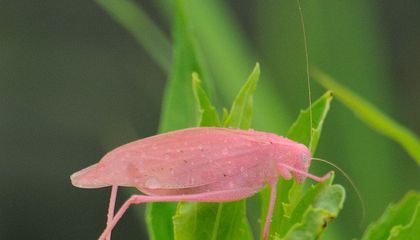



A pink oblong-winged katydid failing to blend in at the Middlefork Savanna Forest Preserve in Lake County, Illinois
(JanetandPhil via Flickr under CC BY-NC-ND 2.0 )
Katydids have a reputation for being brown or green, but some species shatter the stereotype with a bright pink flair. Oblong-winged katydids (Amblycorypha oblongifolia) are one of those species. Breeding experiments suggest this discrepancy isn’t due to a genetic mutation. When a green individual mates with a pink one, they make blush-colored children half the time. So why are fewer of these pink katydids seen?
Blame the power of camouflage, which gives green katydids that resemble leaves a survival advantage in most areas. In contrast, easy-to-spot pink individuals are picked off by predators.
Beware of the ‘Purple People Eater’
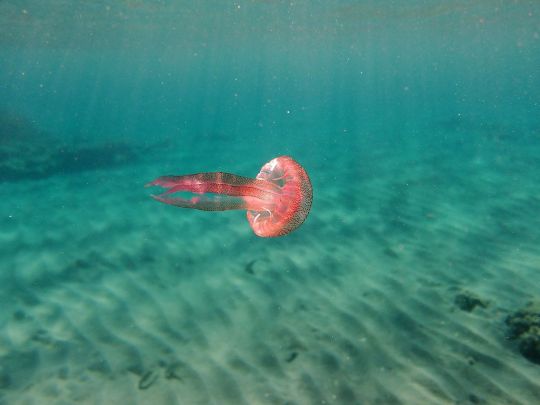
A mauve stinger traveling underwater
(Fco. Javier Gallardo Álvarez via Flickr under CC BY-NC-SA 2.0 )
The mauve stinger jellyfish (Pelagia noctiluca) proudly displays brightly pigmented hues, dazzling the beholder with purple, yellow and even pink varieties. P. noctiluca roughly translates to “night light” in German, named for its ability to leave a glowing trail of bioluminescent mucous behind if frightened. They have stout bell- or umbrella-shaped “bodies” measuring between 3 to 12 centimeters, with long tentacles dangling below.
In Australia, these jellies have a quite shocking nickname: the purple people eater—and for good reason. They’re covered with stinging cells called nematocysts that are able to paralyze their small prey, including planktonic crustaceans and fish larvae, and give humans localized pain.
Amazon River Dolphins May Get Pinker From Battle
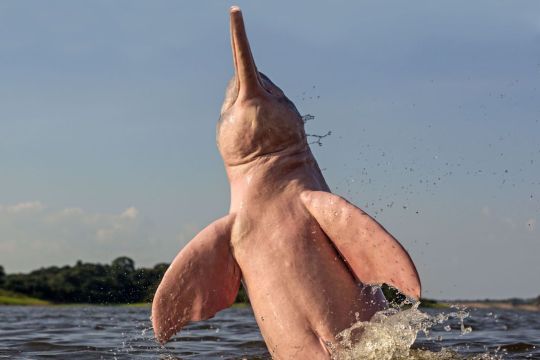
An Amazon river dolphin spyhopping in the wild
(Sylvain CORDIER via Getty Images)
When Amazon river dolphins (Inia geoffrensis) are young, they pretty much look almost like the average bottlenose dolphin one might see at a zoo with a few key differences. They are born with sleek, gray bodies, but feature long, thin snouts and ridge-like humps where a typical dorsal fin would be. But when they grow up, they become even more distinct from good ol’ Flipper.
Some adults in the species develop a gorgeous blush-pink color, hence their nickname “pink river dolphin.” How exactly these animals, also called boto, go from gray in their youth to pink when they mature is unknown. But there is one rather brutally compelling theory: they beat each other up.
Males, who are bigger and more aggressive, tend to also look pinker than the females. It’s possible, then, that their color comes from their scar tissue that appears as they heal from battle. Another idea is that the adults become pink to camouflage themselves in murky red waters to hide from prey. Considering they’re an endangered species, impacted by human hunting and development, that kind of adaptation might be crucial for their survival.
The Rose-Feathered Galah Will Make You Say Ooh-La-La
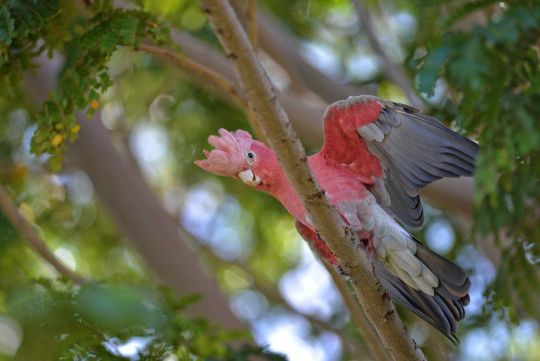
A pink galah on a tree branch in Australia
(Alexandre Roux via Flickr under CC BY-NC-ND 2.0 )
Cockatoos might have the most stylish hairdos in the animal kingdom, and the pink galah’s short, white-feathered crest is among them. Like other parrots, the galah’s raspberry-colored neck, breast and underwings are caused by psittacofulvins, pigmented molecules in their feathers produce color absorbed from light. These molecules are unique to parrots, whereas most other birds get their colored plumage from light-absorbing carotenoid pigments found in their diet, not within their feathers.
Those searching for wild galahs (Eolophus roseicapilla) will need to travel to two locations in Oceania: mainland Australia or a small region in northern New Zealand.
This Super-Pink Sea Slug Eats Tiny Rose-Colored Creatures
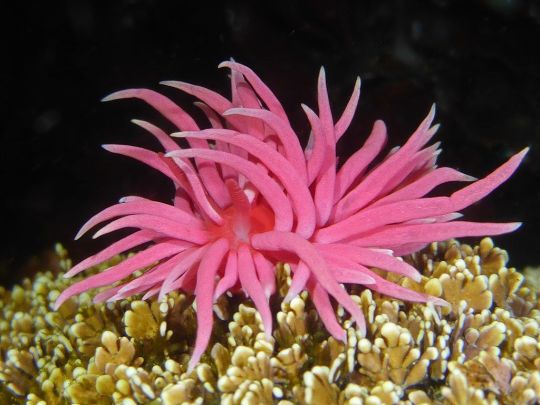
The pink design of a Hopkins’ rose nudibranch signals poisonous danger to predators.
(Robin Agarwal (ANudibranchMom on iNaturalist) via Flickr under CC BY-NC 2.0 )
Despite looking more like sea anemone or some kind of squishy, spiky stress ball, Hopkins’ rose nudibranch (Okenia rosacea) is actually a sea slug—and please don’t give it a squeeze. Aptly named, this North America-based, one-inch-long sea critter is as impossibly pink, save for its white-tipped papillae. Nudibranches use their colors to warn predators that making a meal out of them would lead to toxic consequences.
Unlike other sea slugs, nudibranchs feast on certain creatures, and the Hopkins’ rose variety gets its beautiful color from its choice prey: tiny pink bryozoans, or moss animals. Bryozoans are colonial animals, meaning they live in colonies where individual organisms connect in units called zooids. These Lego-like animals are no match for the Hopkins’ rose nudibranch, however, which has hook-like teeth made to pierce through bryozoans and gobble up the pink delicacies.
This Worm-Like Creature Is Actually a Lizard
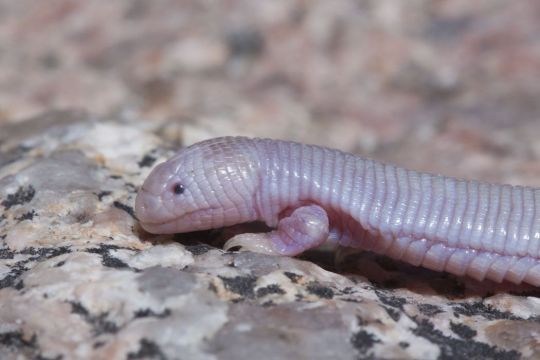
A Mexican mole lizard in Laz Paz, Baja California Sur, Mexico
(marlin harms via Wikimedia Commons under CC BY 2.0 )
Despite its blush-colored, noodle-like frame, the Mexican mole lizard (Bipes biporus) is neither a worm nor a snake. Instead of four legs, however, the reptile has just two tiny forelegs for digging while the rest of its body slithers along. Rarely emerging from the ground, the strange-looking lizard’s subterranean lifestyle causes it to have low levels of color-boosting melanin. This behavior leads to its baby-pink appearance, though it turns white as it matures.
The Mexican mole lizard belongs to a group of legless lizards called amphisbaenians. Of course, since it actually does have limbs, it also resides within a special three-species family called Bipedidae that have front legs, unlike the other amphisbaenians. Native to Baja California Peninsula in Mexico, these critters are hitched to a rather unsavory, baseless myth among locals. Some folks fear the lizard will crawl into certain exposed areas while relieving themselves.
A Fluffy, White Bat With Rosé-Toned Wings

A Northern Ghost Bat hanging from a palm leaf
(Michael Autumn via Wikimedia Commons under CC BY-SA 4.0 )
Not to be mistaken for cotton ball hanging from the rafters, the northern ghost bat (Diclidurus albus) lives up to its name thanks to the soft white fur it sports. Once in the air, however, its translucent pink wing membranes, stretching from the forelimbs to the hindlimbs, are unmistakable. This coloring deviates from the darker membranes more commonly found among bats, helping the ghost bat stand out among its batty relatives.
Where the northern ghost bat’s name deceives is its geographical range. Not found in most of the Northern Hemisphere, instead, their habitat range includes Mexico, Central America, most of Brazil, parts of South America and across some Caribbean islands, including Trinidad.
The species is solitude save for breeding season, which happens to occur in January and February—just in time for the season of love, when members in groups as big as four step outside their bubbles to cozy up together during the day.
This Coral-Colored Seahorse Matches Its Home
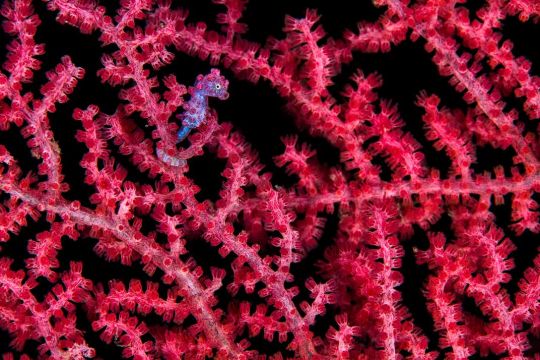
A Bargibant’s pygmy seahorse trying to blend in with its surroundings
(Nature Picture Library / Alamy Stock Photo)
Measuring just under an inch when fully grown, the Bargibant’s pygmy seahorse (Hippocampus bargibanti) doesn’t just rely on its small stature to hide from predators. They instead go one step further: matching their environment with the precision of an expert designer.
The species lives mainly in the Coral Triangle in the western Pacific Ocean, where they reside and feed on gorgonian corals. The color of the pygmy seahorses depends on the coral they live in during their youth. To match their vibrant coral home, they’re usually an orange-yellow mix or a red-pink fusion, with bumps called tubercles aiding their camouflage. It’s unclear yet if the seahorses can change colors if they take up residence elsewhere, or if their coloration lasts a lifetime.
A Mantis Disguised as a Beautiful Blossom

A female orchid mantis, which looks like a generic flower in its environment
(Frupus via Flickr under CC BY-NC 2.0 )
The orchid mantis (Hymenopus coronatus), found in Southeast Asia and Indonesia, uses its white body with ombré hints of pink and yellow hues to draw in other insects for a feast. This appearance, particularly stunning in their juvenile forms, is an example of aggressive mimicry where an animal blends in with its environment to catch prey off guard. However, the orchid mantis doesn’t actually look like any particular flower in its environment.
Rather, the orchid mantis’s unspecific nature is actually a boon. Instead of just attracting specific types of pollinators for the kill, the mantis keeps its menu wide open by appearing generic enough to bring in many unsuspecting insects. It doesn’t need to saddle-up next to blossoms to get the job done either; standing out in the open masquerading as a gorgeous orchid is enough to pull off the charade.
This Dashing Dragonfly Is No Damselfly in Distress
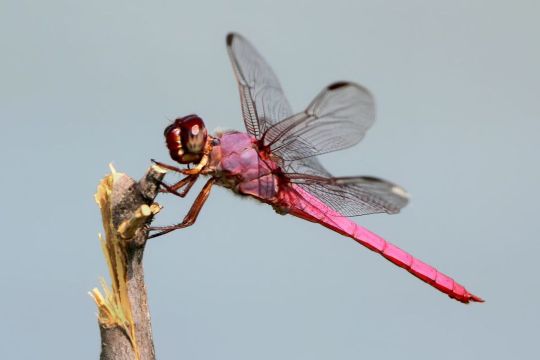
A vibrant male Roseate Skimmer dragonfly at Bob Jones Park in Southlake, Texas
(TexasEagle via Flickr under CC BY-NC 2.0 )
The roseate skimmer is an aptly named dragonfly—that is, for the males. As an animal that exhibits sexual dimorphism, the species’ mature males and females appear noticeably different from each other. The females are decidedly less colorful, taking on a brownish hue. The males, however, show off pink-purple bodies when they reach adulthood. A young male roseate skimmer (Orthemis ferruginea) is certainly a mama’s boy, having a similar appearance to the females before his own maturation.
The species can be found throughout the southern United States, from California to Florida. It also is located in Hawaii and parts of the Midwest and East Coast, Mexico, and Central America. Roseate skimmers prefer inland bodies of water where vegetation is plentiful, and decide to put their eggs even in tiny pools so long as the plants they desire to eat are around.
The Shocking Pink Dragon Millipede Lives Up to Its Name

A shocking pink dragon millipede crawls through its environment, sharply contrasting the drab background.
(Oliver Thompson-Holmes via Alamy Stock Photo)
While the shocking pink dragon millipede (Desmoxytes purpurosea) is considerably smaller than dragons of lore, they are just as intimidating to their enemies as their fire-breathing namesakes. Resembling hot pink limousines of the insect world, the three-centimeter-long millipedes’ vibrant color serves as a warning to any would-be predator: stay away. They have glands that excrete hydrogen cyanide, a highly toxic acid. This strategy—using appearance to signal danger—is known as aposematic coloration.
Aposematic coloration is thought to be the reason for the pink dragon millipede’s coloring because it eats out in the open during the day, perhaps confident that its stunning appearance will dissuade other animals from eating it. The pink dragon millipede resides in northern Thailand. It is also one of the biggest in its genus. In total over 30 different dragon millipedes exist, all around Southeast Asia in countries such as China and Vietnam.
Bubble-Gum Pink Elephant Hawk Moths Live Are Global Sensations
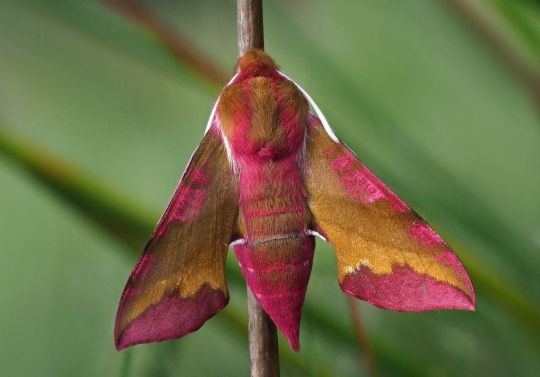
The small elephant hawk moth trades size in exchange for color
(Frank Vassen via Flickr under CC BY 2.0 )
Both the small elephant hawk moth (Deilephila porcellus) and its larger cousin (Deilephila elpenor) rock beautiful bubblegum pink wings outlined in olive set the small elephant hawk moth (Deilephila porcellus). Both insects start out as gray, dusty-looking caterpillars that slightly resemble elephant trunks, hence the name elephant hawk moth. D. elpenor has a gorgeous pink stripe on its abdomen that differentiates it from its smaller relative.
These moths can be found in North Africa, Europe, and even as far east as China. Their location can even impact how vibrant their colors are. Moths in drier and warmer parts of Asia show less, or even an absence of, pink coloring, while moths in northwest Africa and around the Mediterranean sea have brighter colors.
Pale-Pink Naked Mole-Rats Are Resilient Feats of Nature

A naked mole-rat at the National Zoo
(Mehgan Murphy / Smithsonian National Zoo via Flickr under CC BY-NC-ND 2.0 )
As one of the most unique, and perhaps off-putting, mammals in the world, the naked mole-rat (Heterocephalus glaber) is interesting in more ways than one. They are mostly hairless, resulting in a wrinkly light-pink or gray-pink appearance. However, the practically-blind animals have whiskers on their faces and tails to sense their surroundings and hairs on their feet to help them move soil around in their East African underground environment. Naked mole-rats are also the longest-living rodents, with an estimated life expectancy of up to 30 years. They’re immune to cancer, and their risk of death doesn’t increase with old age, baffling scientists. They can even survive better than us humans, as they are able to withstand nearly 20 minutes without oxygen.
Because naked mole-rats cannot regulate their own internal temperature, they get warm using shallow tunnels and huddling together. That intimate contact is also the most action a naked mole-rat will usually get: unlike most other mammals, they are a eusocial species, meaning one queen mates with several males while the rest of the community helps raise the children. Such togetherness will quickly cease if the queen is gone, however. Several females may engage in deadly battle in order for the right to become the colony’s new leader.
This Magenta-Speckled Snake Slithers With Style
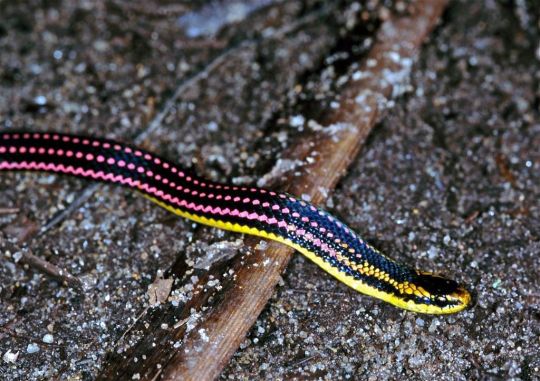
Liophidium pattoni slithers along with its pink-striped scales.
(Bernard DUPONT via Flickr under CC BY-SA 2.0 )
Researched for the first time in 2010, Liophidium pattoni may lack a common name, but it certainly has no shortage of pizzazz. The slithering creature is striped with hot pink speckles against black scales along its back with a bright yellow belly. The underside of the tip of its tail looks as if it was dipped in magenta, almost as if the snake is cosplaying as a mermaid, minus the fin.
The species can be found in northeast Madagascar and is just one of two kinds of snakes with bright body coloration among more than 90 species known to science on the island. Because it is not believed to be aggressive nor dangerously poisonous, its pink pattern may be an indicator of bad taste or even a bluff that it’s harmful to predators. Essentially, it could be an example of aposematic coloration without actual danger lurking behind.
#Nature
105 notes
·
View notes
Text
STUDYING MOOMINVALLEY
Creature Name: Mumrik
Classification: Felidae
Peacefulness (1-10): unknown
Fur type: short
Diet: omnivore
Mumriks belong to the Felidae family, though not fully related to the Catus species. They share attributes, colouring and personality of an average house cat, but their physical appearance resembles that of a human. Nobody knows where Mumriks came from, some believe they were a sub-evolution of the Mimpl (the family from which the Mymbles reside in) family who evolved for survival in certain dangerous areas, and some have come to think they were an early form of human which took genes from the Saber-Toothed Tiger (Smilodon). But no matter how much I research, there is no true explanation as to where these creatures came from.
A Mumrik’s diet consists of small prey it catches in the forest as well as fish. Mumriks have gained human knowledge over the years at the same time as Moomins and Snorks. However, their culture divided them from settling down in the valleys of Finland and they began wandering the Earth. There is a different classification of Mumrik for each country, sharing colourations and breeds with the Catus species. There’s an English Shorthair Mumrik, a Siamese Mumrik, even a Calico Mumrik. But a common attribute of Mumriks are that their skin is always dark, apart from the rare occasions of failed melanin production (vitiligo) or completely light skin. Melanin failure is usually found in the Calico Mumrik, though it isn’t that common. Most Mumriks are born with tails, others not. It isn’t a gender-tied thing, it depends on genes.
When Mumriks began arriving to Moominvalley, female Mumriks started their training to become witches. Mumriks are heavy believers of witchcraft, they wear hats to protect themselves against negative energy and even infuse their hats with different herbal remedies for protection, stress-relief and well-being. Some Mumriks like to carry crystals with them, binding them around their necks, tails or wrists, to protect them against harm on their wanderings. It’s most commonly the females of the species that go into becoming witches, but males still study witchcraft despite not becoming witches. However, a trans Mumrik is seen as one of the more stronger forms of witches because being transgender to Mumriks shows great strength and courage to be yourself.
Not much is known about how peaceful these creatures are, as their personalities vary a lot much like those of the Catus species. Some are quiet, some are territorial, some just go with the flow. You can never truly understand a Mumrik’s peacefulness until you grow a strong bond with one.
(comment which creature you would like to learn more about, and I shall study them)
29 notes
·
View notes
Text
The Furry Report: New Trends in Masculine Chest Hair

I am the middle brother of three brothers. My older brother is quite hirsuit with a thick veldt of chest and stomach hair and hair on his upper back and shoulders. My own chest is quite hairy, but I keep my shoulders and back clean of unwanted hair. My younger brother has a center patch, but significantly less hair that the other two of us. I am sharing that just to point out that among the three brothers our chest hair patterns are all three different from one another and still different from what Dad has.
I started growing chest hair at age 13 and had a fully hairy chest by 15. I got the nickname “wookie” at school because of my hairy chest. I was proud of my chest hair, and unless “commanded” to shave it as a part a member of the swim team, I let it grow. In college, it wasn’t an option; we had to shave.
My own experience has been that a clean shaven or waxed chest was very popular from 2000 to 2016, but a more natural look seems to now be returning as a grooming fashion. That was good news to me. Shaving is not a good option for those of us with thick fur on our bodies.
MASCULINE CHEST HAIR
Chest hair is hair that grows on the chest of a male in the region between the neck and the abdomen. Chest hair develops during and after puberty along with other types of androgenic hair (hair that develops on the human body during and after puberty). According to the New York Times, for a new generation, the overly groomed body appears to be falling out of favor. “We’re seeing a return to ’70s fashion,” said Tim Bess, an analyst at the trend forecasting agency the Doneger Group. “The late ’60s and early ’70s were about freedom, the hippie movement, having lots of hair.”
DEVELOPMENT AND GROWTH
Although vellus hair is already present in the area in childhood, chest hair is the terminal hair that develops as an effect of rising levels of androgens (primarily testosterone and its derivatives) due to puberty. Different from the head hair it is therefore a secondary sexual characteristic. Men tend to be covered with far more terminal hair, particularly on the chest, the abdomen, and the face.
The development of chest hair begins normally during late puberty, usually between the ages of 12 and 18. It can also start later, between the age of 20 and 40, so that many men in their twenties have not yet reached their full chest hair development. The growth continues subsequently until the end of life.
PATTERNS AND CHARACTERISTICS
The individual occurrence and characteristics of chest hair depend on the genetic disposition, the hormonal status and the age of the person. The genes primarily determine the amount, patterns and thickness of chest hair. Some men are very hairy, while others have no chest hair at all. All ranges and patterns of hair growth are normal. The areas where terminal hair may grow are the periareolar areas (nipples), the centre and sides of the chest and the clavicle collarbone.
The direction of growth of hair can make for interesting patterns, akin to depictions of mathematical vector fields. Typical males will exhibit a node on the upper sternum, the hair above which points up and the hair below which points down. Some individuals have spirals on their upper pectoral regions (several inches from the nipple towards the neck) which run clockwise on the left breast and counter-clockwise on the right.
Considering an individual occurrence of chest hair as abnormal is usually not due to medical indications but primarily to cultural and social attitudes. An excessive growth of terminal hair on the body of men and women is called hypertrichosis. This medical term has to be distinguished from hirsutism that just affects women. These women can develop terminal hair on the chest following the male pattern as a symptom of an endocrine disease.
SETTY PATTERNS
Four areas in the Setty chest hair pattern system: infraclavicular (top), pectoral (left), sternal (middle) and circumareolar (right)

There have been occasional studies documenting patterns of chest hair in men and occurrence of these patterns. A study of 1,400 white men aged 17 to 71 conducted by L.R. Setty in the 1960s defines 15 patterns of chest hair. In this study, four parts of the chest in which terminal hair occurs were identified:

There have been occasional studies documenting patterns of chest hair in men and occurrence of these patterns. A study of 1100 men aged 17 to 71 defined and documented ten patterns of chest hair in Caucasoid men. In this study 6 percent of the men were found to have no chest hair. The largest group, 56 percent, displayed pattern four as shown in the accompanying figure. The remaining 38 percent of the men displayed a lesser quantity of chest hair. Seven percent displayed pattern one, 13 percent displayed pattern two and 18 percent displayed various other patterns.

WHAT PERCENTAGE OF MEN HAVE CHEST HAIR?
74% (Sternal) The center and lower part of the body of the breastbone
63% (Infraclavicular) The area immediately below the medial end of the collarbone
77% (Pectoral) The breast area, including the area immediately around the areola (nipples)
16% (Circumareolar) A small area immediately encircling the areola.
6% No chest hair. The pattern of no chest hair may be found predominately in Native Americans, Ireland, UK, Germany, Austria, Switzerland, Czech Republic, Poland, Ukraine, Southern Russia, Netherlands, Denmark. Unhairy - Majority of population not hairy (e.g. a lot of men don't have chest hair) Norway, Sweden, Finland, Baltic States, Northern Russia.
Chest hair may occur on each of these areas independent from the others, making for a total of 15 combinations in addition to the apilose (bare) pattern. Hair is said to occur on both the pectoral and circumareolar areas when there is hair around the nipples and on the breast, but these areas are not connected.

What Your Chest Hair Should Look Like
Chest hair can be pretty divisive. You are either really into it, or not. Even if I had to look at it objectively, some of the manliest men of all time had quite a bush. James Bond, Anil Kapoor and Chuck Norris—to name a few. Yet, there are some handsome hunks who can pull off bare-chested look like a boss. Case in point - Ryan Gosling, Ranveer Singh or Salman Khan. The truth is with such a laudable amount of care going into manscaping, I thought it’s only legit to inform you about the top styles that can accessorize your chest. Here goes!
The Rug
It symbolises manliness like no other chest hairstyles. It’s the ‘daddy cool’ style, which is, more often than not, sported by men who’re old enough to be fathers. With celebrity supporters including Tom Selleck, Akshay Kumar and Alec Baldwin, it’s no wonder the style has to be worn proudly. Just keep the look under control with constant quick trims.
The Tree
As the name suggests, this version of the style has moderate amount of hair on the upper torso with a small trail leading south. It’s rather popular among young guys who don’t want to come across too bushy but also don’t want to part ways with chest hair. This evergreen approach, as a result, let boys sport a happy tree throughout the year.
The One Sided Affair
This one is the manscaping underdog, and characterizes a well-trimmed hair on the top half of the chest but a smooth bottom half. Smooth can become stubble but that’s as far the length of the hair on the bottom half can go. As seen on Don Draper, this look is popular and is sported by men of all ages.

Gay Otter: A man with think or thickish athletic build that usually has lots of body hair. Typically, this hair covers various parts of the torso, including the chest and stomach. Some otters also have hair on the arms, back and butt.
Gay Wolf: A man with a lean, muscular build. Usually has body hair on the chest and/or torso region. Almost always has facial hair.
Gay Bear: Broadly-speaking, a bear is hairy, with a large build and over 30-years-old. They are hunky, chunky, often with bellies, big legs, big butts and almost always with a full beard or facial hair.

46 notes
·
View notes
Text
Benefits of shaving pubic area female – Is it good for a woman?
Our grandmas would have not even imagined discussing the hair down there, but thanks to the media and internet we girls are here researching, debating, and exploring our options on how to groom that little bush. We have so many questions to enquire? Does pubic hair have any purpose? Are there any health benefits associated with them? Can we really fully shave them? Would there be any side effects after shaving them? Here we will try to understand what is pubic hair and the pros & cons of shaving it.
1. Difference between female pubic hair and body hair?
Before we see the difference between the hair in the genital areas to that of the hair in other visible areas of the body, one should know that three main types of hair grow on all human beings. First is the Lanugo hair, the hair growing on the fetus, which is lost once the baby is born. Second is the Vellus hair, the thin, short, and light hair, which covers almost the complete human body except for some areas like the back of the ears, palms of the hands, soles of the feet, etc. The third is the Terminal hair or the Androgenic hair, long and thicker hair, which during puberty replaces vellus hair in certain areas of the body like arms, armpits, legs, pubic, facial hair, etc. The length, color, and thickness of terminal hair vary from person to person depending on the hair growth rate and genes.
2. Pros and cons of shaving female pubic hair:
If you think pubic hair is just a thick bush of wiry hair that is present for no reason, then you are wrong! First of all, these hairs mark the sign of puberty and also acts as a protective shield of the vagina. Following are some of the pros and cons of clean shaving the female pubic hair;2.1. Pros:
Shaving pubic hair has become an aesthetic social norm. Women do it because they believe their genitals look attractive after shaving.
A smooth and soft vagina looks more appealing to sexual partners.
Shaving results in a much cleaner appearance.
Since there is no hair, there is no more sweat and itchiness.
Pubic hair locks the sweaty smell of your vagina and produces a strong odor. So, shaving them eliminates that odor and makes you feel fresh.
Shaving gives you a lot of advantages in dressing. You can flaunt different swimsuits and leggings.
Removing pubic hair increases sexual sensation resulting in a more pleasant experience.
There is no hair and there is no chance for a germ or lice attack.
2.2. Cons:
Removing the safety guard means, you are prone to more infections.
Pathogens and bacteria can cause UTIs, vaginitis, and yeast infections.
Shaving can irritate your skin, leading to skin problems like cellulitis and folliculitis.
Cuts, burns, and rashes are the most common injuries that can occur because of shaving.
Pubic hairs grow back faster and thicker and hence you have to do remove them regularly to avoid the bush.
3. Health benefits of pubic hair female:
As we mentioned earlier these coarse pubic hairs are existing for some reason. They provide some surprising health benefits to women. Some of them are as follows;3.1. Maintains the temperature of the genitals: We all know that animals have fur to keep them warm. Well, our human bodies are not different from them. Hairs serve the purpose of keeping our body warm and pubic hair does the same by maintaining the temperature around female genitals.3.2. Prevents skin rubbing and acts as a buffer: Pubic hair acts as a protective pillow to protect your skin from the friction that may arise from the rubbing of skins during intercourse. This defensive barrier also serves as a shock absorber, when you do certain exercises like cycling.3.3. May reduce the risk of getting an infection: Like how eyelashes protect your eyes, pubic hair acts as a wall and does not allow any dirt, germs, bacteria, and pathogens to enter inside the vagina. The pubic hair follicles produce an oil called sebum, which stops the microorganisms to reproduce and thus minimizing the risk of getting infections.3.4. Attract even powers due to pheromones: Pheromones are scented chemicals secreted from apocrine sweat glands, which are abundant in the pubic region. People believe in the theory that these pheromones are trapped inside the pubic hair and their smell can be sexually tempting and enticing for your partner.
4. Top benefits of shaving pubic area female:
Shaving pubic hair is totally based on your personal preferences. If you are determined to make that choice, “say hurray!”, you get to enjoy the following cool benefits;4.1. Eliminating odor: When you get rid of your pubic hair, you also remove the apocrine sweat glands. This will leave you with an odorless vagina.4.2. Healthier: Once you shave the bush, your pubic area will look much cleaner without any itching or irritation.4.3. Better intercourse: Studies say that men are more attracted to hair-less pubes. If you find oral sex fascinating, then you should definitely go for shaving your mound with a nice sharp razor.4.4. Increased sexual activity: Some theories suggest that there is a link between vaginal hair removal and sexual functionalities. Many young people report that there is an increase in sexual sensation after they remove their pubic hair.4.5. Looks better: Having soft and smooth vaginas make women feel more confident and comfortable in dressing whatever they like.
5. Possible consequences of removing pubic hair:
Depilatory creams can cause chemical burns to your sensitive skin.
There can be redness, irritation, and itching after removing the pubic hair.
Cuts, bruises, and boils can appear.
One may get infected with “Hair root infection” which is commonly caused due to shaving.
6. Should one use an electric razor for pubic hair removal?
Electric razors are long-lasting, portable shavers that come with a variety of additional features. One can even choose to have a dry or a wet shave depending on their preferences. Electric razors are safer than manual razors because there are fewer or no chances of cutting. However manual razors can provide a quick and close shave than electric razors, with a high risk of getting injured. You can choose by deciding which shaving method would best suit your needs and lifestyle.
7. Side effects of pubic hair removal:
As mentioned earlier, some consequences or side-effects are resulting from shaving pubic hair. There are some suggestions to help you treat these at your home, but you may have to consult the doctor for a permanent solution.7.1. You can relieve the discomfort in the following ways:
Soak yourselves in a warm bathtub or take a warm shower. The hot water will help you in cooling off your bruises.
You can also try keeping your vaginal area dry by patting the area gently with a clean towel.
Once you finish drying, apply skin moisturizing lotions. This will avoid any irritation or burns.
Give your labia a break! Stop shaving until your skin gets completely healed from any infection.
8. Safety guidelines for shaving the pubic hair:
The skin present in the labia is very different from the skin on other parts of the body. It is very thin and less taut. It also has more nerves ending at its surface which makes it more sensitive for shaving. But if you follow the following safety guidelines you would get a scar-free shaving experience along with a smooth fur-free vagina.
It is given that you cannot see your vaginal area properly during the shaving process. So, you can use a hand mirror to see clearly and to avoid any cuts.
You can cut the long hair with a sharp scissor before shaving.
Warm water helps in softening the pubic hair which in turn eases the process of shaving.
Gently exfoliate the skin with pH-balanced shaving cream or gel. This will help to loosen up the trapped hairs.
Always use a sharp razor for a neat and closer shave.
Sterilize the razor before you use it.
Start shaving with slow movements in the direction of the hair growth.
Do not forget to rinse your razor in warm water after every single stroke.
Once you finish shaving, rinse your skin in a warm shower and dry your skin gently by patting it with a towel.
Develop a post-shave care routine by applying a lotion or moisturizer. Hydrating the skin is a must to avoid any irritation or itchiness.
9. Tips for shaved genitals:
Here are some additional tips on how to shave and how to take care of your skin and maintain it after the shave;9.1. During hair removal:•Razors with easy-grip: For better control choose razors with an easy-to-grip handle, when you are shaving in the shower. •Shower or bath mat: Use a shower mat or bath mat to avoid any accidental slips and slides.• Water temperature: The temperature of the water should be neither too hot nor too cold. It has to be just warm.9.2. After hair removal:
Say no to tight lingerie: Very tight-fitting underwear can cause irritation to your just shaved soft vulva. Wearing cotton panties is a good solution.
Do not expose your skin to the sun: Let your skin recover after shaving before you go out in your swimsuit to get a sunbathe or enjoy your time in the pool.
Pay attention to abnormalities: If you see any abnormal changes in the labia, check with your dermatologist immediately to avoid any unnecessary complications.
10. Conclusion: Most of the girls shave their pubes because their partners ask them to do so or they would like to look better for their gynecologist visits. Ultimately, what you do with your hair, whether you trim, shave or leave it natural, is all up to your preferences.
6 notes
·
View notes
Text
Kelusine Species Sheet
BASICS
Name: Kelusine
Height: 2’6”-6’0” at the shoulder
Weight: 900~ lbs-2000< lbs
Diet: Carnivore
Classification: Planetary, Natural, Non-Magic Sensitive, Sapient, Feral, Feline
Trainable: Yes
Temperament: Territorial, Protective, Energetic, Playful
Danger Level: Medium
Lifespan: 170-180 Kelusian Years
Litter size: 2-4 cubs
BIOLOGY
Morphology: Immense felines, they are quite similar to the big cats of Earth aside from their strong saber teeth (which range from 4-8 inches) and thumb-like appendages in place of their dew claws. Males have lion-like manes whereas the females sport a short mane along the nape of their neck. In certain subspecies that reside in colder regions (Mountaineers and Wastelanders), the females’ manes may extend to their shoulders and belly.
Subtypes:
Islander: The swimmers and climbers. Found in low level coast forests in tropical regions and, as their name suggests, on island chains connected by shallow expanses of ocean. The smallest species, this cat resembles a Cloud Leopard in structure and their ankles can rotate backwards, just like the real life cat’s. This enables them to climb down trees headfirst, climb upside down, or even hang by their back feet. These cats reach only two and a half feet at the shoulder.
Plainer: The runners. The second smallest in shoulder height (4 ft), yet the second longest (14ish feet) thanks to their lengthy tail, Plainers are built purely for speed. Living on the wide open grasslands, they rely on quick bursts of speed to take down their prey. Their long tail acts like a rudder, just like a cheetah’s would, which enables them to make sharp turns with minimal warning.
Forester: The jack of all trades. An intermediate of the five subspecies (4 ½ feet at the shoulder), Foresters resemble the tigers of Earth in build. Strongly built without sacrificing speed, Foresters live in, you guessed it, forests. They prefer hardwoods with mixed pines, but can adapt to Alpine forests or mid-latitude jungles and woodlands.
Mountaineer: The jumpers. Closely resembling snow leopards or mountain lions, Mountaineers are found in similar environments; high altitude snowy mountains. Thick fur keeps them warm in the frigid air, and a thick tail helps them balance while chasing prey across steep slopes. Unlike snow leopards, however, Mountaineers are immense and rank #2 height (5ish feet) and #1 in length from nose to tail tip (16ish feet).
Wastelander: The bone crushers. Unlike the other subspecies, which have body types based primarily on existing big cats, Wastelanders get their inspiration from smilodons and grizzly bears. Built for pure power with strong shoulders and immense front paws, Wastelanders are the largest of all Kelusines with shoulder height measuring six feet and even seven in rare cases. They are also the only subspecies with a short tail.
Colors:
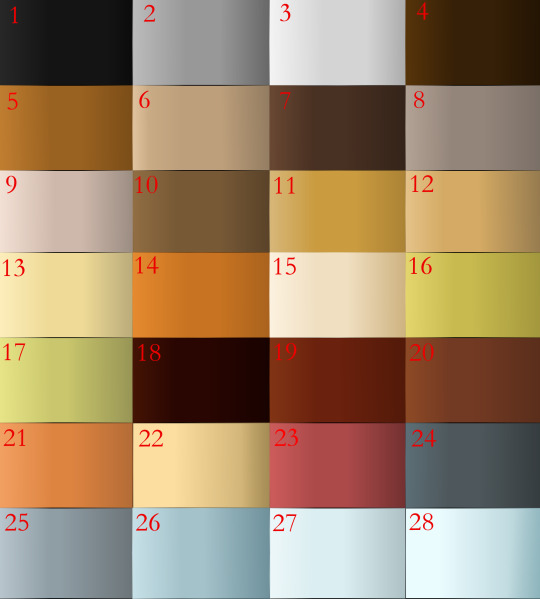
Standard:
Black
Grey
Silver
Brown
Light Brown
Tundra
Chocolate
Lilac
Fawn
Brown Ash
Golden
Tawny
Cream
Orange
Peach
Green Ash
Yellow Ash
Russet
Russet Brown
Cinnamon
Red
Strawberry
Red Ash
Blue
Blue-Grey
Chinchilla
Moonstone
Blizzard
Modifiers:
Colorpoint: Dilutes the base while leaving the extremities (face/tail/paws) normal
Reversal: Switches the color of the base coat and markings (ex: black with white stripes)
Light: Turns the inner marking of rosette/smeared/clouded/snow spot lighter than the base coat
Pied: White covers 25%-90% of the beast in solid patches
Splatter: White “paint splatters” cover 10%-50% of the beast
Tortoiseshell (Female only): The “red” gene is active and causes discoloration in patches.
Patterns:
Standard:
Common
Blotched Tabby
Brindle
Mackerel Tabby
Plain (no pattern)
Spotted Tabby
Ticked Tabby
Uncommon
Cheetah
Clouded
Dapple
Ocelot
Speckles
Rare
Double Dose (Spots on body and stripes on extremities)
Rosette
Snow Spot
Wild
Mutations:
Chimera (Two different base colors and markings)
Split (Two marking types)
Albino
Melanistic
Fallen Snow (Sabino along dorsal side)
Drift (Sabino along ventral side)
Glitch (Markings are broken and missing in some places)
Mist (Markings fade towards dorsal side)
Fog (Markings fade towards ventral side)
Storm (Markings in thin vertical bands)
Physical Mutations:
Mane:
Razorback (mane continues to tail)
Rimmed (mane along forelimb and back limb undersides; not found in Islanders or Plainers)
Curtain (long fur resemble horse mane; not found in Islanders or Plainers)
Static (Long and stiff along spinal area)
Scruff (Longer chin fur; standard Wastelanders)
Tail:
Bobtail (Stump)
Angel (longer silky fur)
Short (Akin to a wolf; standard for Wastelanders)
Ears:
Pointed (triangular rather than semi-circle; standard for Islanders)
Tufted (Lynx-like; standard for Wastelanders and Mountaineers)
Horned (Curl backwards)
Folded (Folded downwards)
HABITS
Habitat: Thanks to the abundance of specialized subspecies, Kelusines are one of the most diverse species in terms of location. They can be found almost everywhere apart from the far poles, deserts, and swamps. Large carnivores, they require an area rich in prey and thus control large swaths of territory either as a clan or as individuals.
Diet: Hypercarnivores, Kelusines require meat. They are not picky when it comes to meat, although shy away from carrion or cannibalism and a vast majority will not eat humans. One exception is the Wastelander subspecies, who will eat whatever prey they can catch. And humans are easy prey; dumb and slow.
Intelligence: Kelusines are one of the most intelligent animals of Kelusia. Like most creatures, they can speak Basic, or English. However, they are one of the few species that can learn languages other than their own and Basic. Kelusines are also one of the few that can operate high level technology. Some actually possess a Communication Watch on their wrists. Able to comprehend advanced math and science, Kelusines still prefer subjects that deal with history, natural science, and technology.
Social Life: Social creatures, wild Kelusines often live in small prides that consist of 5-7 individuals. However, sometimes to expand their territory, prides will join and make larger groups, or clans, of around 10-20 individuals, depending on the amount of prey available. When in clans, Kelusines have a ranking system to help things flow smoothly within the clan. The “head” positions are the Leader, Medic, and Deputy. Below that is the bulk of the clan, divided further into equal subgroups: Scouts, Operators (tech), Hunters, Guards, Milk Givers, and Elders. Below that rank the Trainees, who are the Kelusines ages 4-12 years, and finally come the Cubs, or Kelusines under the age of 4.
Life Cycle: Kelusine females carry for 9-10 months. There are 2-4 cubs in a litter, on rare occasions 5. The cubs are born helpless and cannot see or hear a week after birth. It is not uncommon for an expectant mother who resides alone to seek out a clan who will let her stay with them the first week or so after her cubs’ birth. She does this to ensure that her cubs are not killed by a rival or possibly a jealous male.
At two weeks, Kelusine cubs are stumbling around on stubby, unsteady legs. By now they can hear and see. They resemble fluffballs on sticks, their fur soft as down feathers. At three weeks, they can walk on their own without trouble and are play fighting with littermates or cubs near the same age if there are any. Around two months they are introduced to solid food. However, they continue to nurse until they are 9 months. At two years they begin to learn how to hunt for their own prey. They are usually taken out by both their mother and father if in a clan. If not, the mother or an older sibling will take them.
Kelusines are considered cubs until year four. By that time they are the size of a teenage tiger or lion. From year four to twelve they are considered adolescents. By now they are about the size of an adult lion or tiger. During the teenage years, Kelusines’ manes begin to grow. Their saber teeth also grow longer and stronger. Unless they grow up as rouges or loners, Kelusines begin to learn the basics of fighting at age twelve. If they were born outside of a clan, Kelusines often learn to fight sooner.
At sixteen years, Kelusines can make it on their own with no extra help. However, they are not considered full adults until age twenty. Females mature, both sexually and mentally, faster than males. They are considered mature at eighteen, while it takes males until year twenty. After a Kelusine reaches age twenty, they may leave to explore or may look for a job as a mount.
Kelusines are a unique species in that they are biologically immortal. The oldest Kelusine on record, a Forester by the name of Powerful Huntress of the Mountain Pass Pride, reached 220 Kelusian Years. However, most Kelusines only make it to 160-180 KY due to an oddity within their genes that becomes active around that age and produces similar symptoms to the viral infection rabies. Instead of intense fear, the Kelusine will become extremely aggressive, attacking anyone and anything in sight. This is not contagious, as it is not an infection, but there is also no cure for the affliction referred to as “Old Age Rage”. The only way to stop an OAR Kelusine is, unfortunately, to kill the beast.
Vocalization and Body Language: Like many of Kelusia’s unique fauna, Kelusines can speak Basic but also, as said earlier, have a unique ability to learn other languages such as Ragera. However, when they talk it is noticeably more guttural and rough compared to human speech. Aside from being able to speak “civilized” languages, Kelusines can make a wide variety of feral sounds. They have the ability to roar, snarl, growl, chuff, cough, groan, and hiss. Younger Kelusines can purr, but they do not have the ability to roar until age 5. Islanders and Plainers cannot roar no matter their age, but instead, like cheetahs, can purr through adulthood.
Kelusines are also heavily reliant on body language. Their body language heavily mimics the tigers of Earth. A calm Kelusine has a relaxed body posture, and the tail hangs languidly. When curious, their tail will be raised high in the air and their ears will be forward in interest. An aggressive Kelusine will bare its teeth, widen its mouth, enlarge its pupils, and flatten its ears.
OTHER
Ridability: Very human-like in their intelligence and readily available, Kelusines are not hard to come by. Kelusines are perhaps the most common mount as living with riders ensures a constant, easy food source while also making sure they get their exercise. That being said it is crucial for riders to understand Kelusines are not pets. Rather, they are companions who have agreed to carry the rider on their back. It is also important to keep in mind that, while Kelusines do have the intellectual capabilities of a human or higher creature, they are still highly dangerous predators who can turn on you if they so please. So treat them well.
Common Uses: Mounts, Guards, Guides, Rangers.
2 notes
·
View notes
Text

Featured breed: laperm
Yeah, the last cat really is a pointed karpati! (Well, it's a mink.) Note the white ears and lightly colored legs and tail, both of which is unusual for a standard colorpoint cat.
genetics guide
Color restriction (tyrosinase, TYR): Mutations on this gene will result in temperature-sensitivity in the pigment production, the cats will be lighter on the warm and darker on the cooler areas of their bodies.
dominant allele: C - regular pigment production, full colored cat (wild type)
allele: cb - moderately reduced pigment production: burmese color restriction, sepia cat (variant)
allele: cm - reduced pigment production, bangkok color restriction, mocha cat (variant)
allele: cs - highly reduced pigment production: siamese color restriction, pointed cat (variant)
recessive allele: c - no pigment production, albino cat (variant)
Order of dominance: C > cb = cm = cs > c
For the sake of aesthetics, the only variant allele I depicted is the rarest cm.
further destription in this post
Karpati (?): This unidentified gene makes the extremeties (face, ears, legs, tail) white kinda like a reverse colorpoint cat, and causes a roaning effect: scatters white hairs everywhere on the body.
dominant allele: K - whited extremities, karpati cat (variant)
recessive alleles: k - normal pigmant production, full colored cat (wild type)
further information in this post
Bonus: Temperature sensitivity
I've mentioned previously that colorpoint and karpati kinda looks like each other's inverse.

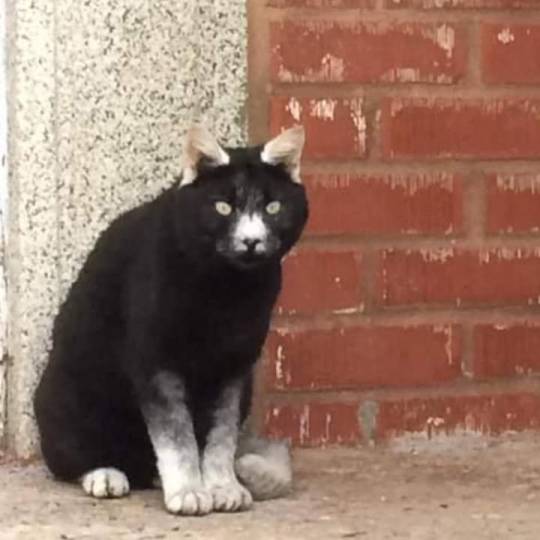
(This cat has a very good karpati effect, most of them has lot less white on their nose and around their muzzle - most likely it's a quite old one.)
Do you know what connects the body parts that are dark on a pointed and light on a karpati cat?
Well, look at this image:

It's an infrared photo; it shows the heat emission from the cat. (Well, if it's real. But even if this particular illustration is computer-made, the phenomenon it shows is real.) You can see that the legs, the tail, the face and the ears are the coldest areas.
The pigment production in colorpoint and presumably karpati cats is heat-associated: it's efficiancy declines or rises with the temperature.
Before they born, the kittens bath in the even warm of the womb, so first they're even colored: white for a colorpoint and almost full black (or the respective color) for a (hezerozygous) karpati.
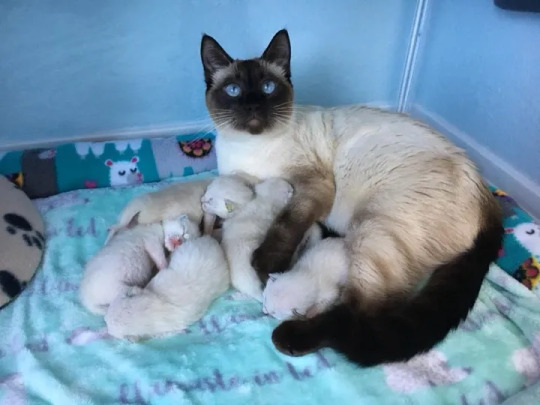

An all colorpoint litter and a karpati litter with one(!) non-karpati. Look for the white ears!
After a few weeks, their colors are already much more developped:

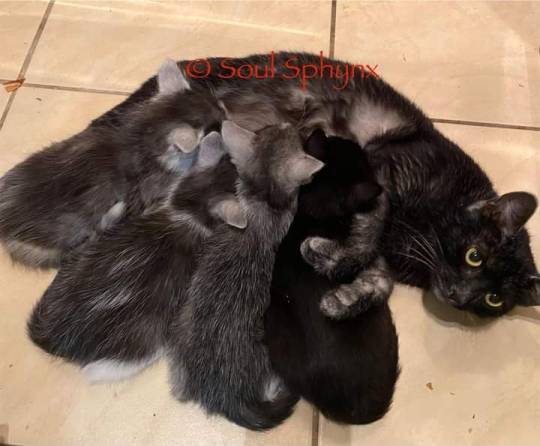
(Same litters as above)
Oké, actually we don't really know how karpati works. Some heat sensitivity is very likely, but the cats' color changes during their lives definitely don't depend only on the temperature, since these very spectacular kittenhood patterns quickly fade away and then comes back slowly and very differently depending on individual. (Again, this is only true for heterozygotes. Homozygotes don't lose all their whiteness.)
The temperature sensitivity can result in really funny patterns in colorpoint cats: if a cat loses some of its fur for some reason, and later it grows back, it'll be noticeably darker then the surrounding area, because the naked skin means the temperature is lower there.

This cat from messybeast had a leg injury that needed surgery, so now he wears pants until the next molt.
#polls#cats#cat genetics#macska#genetics#tournament poll#round 3#color restriction#karpati#cat color gene tournament
14 notes
·
View notes
Text
so now that i’ve officially delved into the supernatural au realm here , i decided to write out what my kind of like , lore is when it comes to werewolves and vampires . it’s open to tweaking and working around other peoples’ lore since well . . . i wouldn’t have my pack and ( future because at the moment i have ONE vampire but i’m sure more will come ) coven without inspiration and love from two of my lovely mutuals and i also know everybody has their own ideas when it comes to the supernatural . so yeah , under the cut will be werewolves and then i’ll reblog and post vampires .
** please note that if there is anything you don’t agree with or don’t h/c that’s fine because everybody is different and while this is how i see my lore and i am open to picking and choosing .
** omegaverse traits such as : knotting , slick , m-preg ARE NOT a part of this . heats and ruts aren’t a THING either , just a heightened sex drive .
WARNING : this post is most likely going to be LONG .
** UPDATED - 10/20/2020 , updates will be bolded.
☾ lycanthropy is both a gene and a disease and are viewed as “ pureblood “ and “ half-blood “ .
☾ a pure-blooded werewolf is a wolf whose family has bore the gene dating back to an unspecified date .
☾ a half-blooded werewolf is a wolf who was either bitten or scratched by another half-blooded or pure-blooded wolf while they were in their wolf form .
☾ while both can turn anybody , a pureblood has a higher chance than a half-blood . a pureblood has about a 90/10 chance whereas a half-blood has more of a 60/40 chance . those who DON’T turn useless end up dying due to their bodies rejecting the change .
☾ if purebloods have children with humans , their children will almost ALWAYS carry an active lycan gene . it’s not often that they do not , and those who have an inactive gene it does not mean that they can not pass an active gene onto their children .
☾ if half-bloods have children with humans , their children usually will NOT become a lycan due to it being more of a disease than a gene for them . half-bloods and purebloods are more likely to have a child with the gene.
☾ children who have an inactive lycan gene can have it activated in cases of traumatic and/or life-altering situations , such as witnessing a traumatic event or the death of a parent who acted as lead alpha ( this usually results in the child being taught to become the next lead alpha with an interim one until they are able to take over ) . they can also have it activated by being bitten/scratched just like a human but still retain a pureblood status if born as the child of pureblood parents .
☾ every full moon werewolves will turn , but are also able to turn whenever they want to as well .
☾ shifting has A LOT to do with control . a freshly turned wolf will have a much harder time than someone who has been doing it for years ( unsurprisingly . )
☾ it also is dependent on your mental wellbeing and health . rage or strong anger is likely to cause an unintentional shift in someone compared to someone who is calm and collected .
☾ wolves in a weakened state also are more likely to turn as it is easier to heal their bodies in their wolf form anyways .
☾ pack dynamics are a thing : alpha , beta , and omega , and packs are very common within their realm. all ranks can be male or female .
☾ alphas : there can be more than one alpha in a pack but there is only one lead alpha . they usually have at least one other alpha in the pack but within family packs there are sometimes up to half a dozen .
— leaders and commanders are the two subcategories of an alpha .
— an alpha’s wolf tends to be the largest of them all . their eyes are either red ( marking a packless wolf ) or silver ( marking a pack alpha ) when in their wolf form .
— are physically stronger and built more muscular than betas .
☾ betas : while it’s ultimately the alpha’s job to protect the pack , betas are somewhat the soldiers of the group and make up the majority of packs .
— enforcers and mediators are the two subcategories of a beta .
— betas depending on their ranking are usually in between sizes of an alpha and omega . their eyes are blue whether packless or not in their wolf form .
— leaner than an alpha . their bodies are built more for speed and agility .
☾ omegas : usually the mother hens of the group , omegas are often mistaken to be the weakest members of the pack and underestimated .
— the peacemakers and healers are the two subcategories of an omega .
— assumed to be much smaller than alphas or betas , omegas actually are about the same size of a beta . their eyes are either yellow-green ( when packless ) or gold ( when a part of a pack ) in their wolf form .
— also on the leaner side . coats tend to be a little more fuller than an alpha or beta’s though which make them look bigger than they are.
☾ their wolf forms are just oversized wolves . they’re taller than the average wolf , usually around three to three and a half feet tall but no more than about six feet long .
☾ things like dyed hair do not affect their fur color.
☾ their eye color changes in wolf form , and a giveaway to someone being a werewolf while in human form is the slight ring of the color of their eyes in wolf form that is around their pupil .
☾ their eyes will flash between colors if feeling threatened or challenged .
☾ males tend to be bigger than females .
☾ as wolves , they have heightened senses , supernatural speed and reflexes , and accelerated healing abilities .
☾ while all of these traits follow over into their human forms , they aren’t as heightened as when in wolf form .
☾ when it comes to healing , minor cuts , scratches , and bruises usually disappear after an hour or two . deeper cuts take two - three days depending , broken bones as long as they aren’t open fractures take one - two weeks depending on severity .
☾ things like tattoos and piercings do not grow in or fade for unknown reasons .
☾ their temperatures run higher than the average human , usually between 100 - 104 F . this makes hospital visits complicated as it’s assumed they are running a low grade fever .
☾ they do not change into half-wolf half-human beings , but their canines and claws can elongate in human form if angered or agitated enough . no fur or ears though .
☾ silver and wolfsbane are not deadly but react more like an allergic reaction .
☾ silver often will leave the skin it touches red and inflamed , if worn for extended periods of time it can cause minor burns .
☾ wolfsbane when ingested will cause a severe allergic reaction . common symptoms can include : chest tightening and difficulty breathing , rash / hives , watery eyes , swollen lips / eyes / tongue / face , vomiting , and in serious cases collapsing .
☾ while they don’t live longer than the average human , they physically age slower than humans .
☾ everybody has their own distinct scent .
☾ visible scent glands may have been in their ancestors but have since darwined themselves out . while a wolf gives of a specific scent in general , the strongest areas you will smell them will be : the neck and wrists .
☾ scenting is common in packs , as it shows a sense of camaraderie and belonging amongst them . scents of non-pack members tend to be off-putting to some.
☾ scenting is often seen as intimate and is usually reserved for mates , family members , and pack members .
☾ if a pack is inducting a new member , scenting is usually forbidden until the lead alpha has openly scented the person .
☾ a person’s scent can give away a member’s emotions , mainly : contentment , fear , anger , distress and sadness .
☾ a person can also manipulate their scent in order to calm another person down .
☾ like their animal counterparts , werewolves mate for life .
☾ wolves are able to find their mates once they turn eighteen.
☾ while you may be able to find your mate before eighteen , you aren’t able to define that feeling until after their birthday . mating with a childhood friend isn’t uncommon if you’ve stayed close until then .
☾ the rejection of a mate is not a deathwish , and while you can move on , the connection will never “ feel right “ and it isn’t uncommon for the rejected mate to never have a long-lasting relationship .
☾ some wolves may come off as what is called “ feral “ amongst groups.
☾ this essentially is summed up as a member who has a closer connection to the wolf side of them .
☾ “ feral “ members are often more territorial , less open to new pack members , and have a bit more trouble controlling their emotions .
☾ they are better in tune with their animalistic instincts , especially their sense of smell and reflexes .
☾ feral members tend to be more comfortable in their wolf forms .
☾ there can be entire packs of feral wolves , usually more traditional packs .
☾ the closer to the full moon the more instincts come out for them . usually it’s the week leading up to the full moon that this happens .
☾ the closer to the full moon , the more they feel the connection to their wolves .
☾ for feral members , this time is normally when they’re in the best mood possible because they aren’t having to tamper down these feelings .
☾ during the week up until the full moon they typically have a heighten sex drive , a pull to spend more time and be closer to their pack , and aggression towards other werewolves who are not a part of their pack .
☾ there is usually an underlying itch to revert to their wolf counterpart during this time as well .
☾ wolves can often be very possessive of whoever they are currently seeing and / or mates and are often very connected to them .
☾ while more mature and older wolves can reel in their need to mark their significant others , the younger ones often mark each other with hickeys and even sometimes bite marks .
☾ pack members who are in a relationship or mated tend to smell more like each other than anybody else .
☾ there are two different types of bite : a mating bite is done with elongated canines and results in a permanent scar . a mating bite’s scar when healed is two crescent shaped marks that are the width of the space between one’s canines . a marking bite is a bite that is done without the canines and just looks like someone bit you . . . which they did .
☾ marking / mating bites are usually done on the shoulder or juncture of neck and shoulder .
☾ those in a relationship or mated tend to be more in tune with the other . they naturally gravitate towards each other in social situations and can tell when if something is wrong , and are better at knowing where their significant other is . ( ie : you can tell which room where the other is without seeing them or previously knowing they were there or can tell they’re home before anybody else hears a knock on the door or the door opening . )
☾ younger wolves are typically called pups amongst their packs and it’s a common term of endearment .
☾ while there can be small packs within a city , usually there are larger packs who look over the others ???? it’s not exactly a monarchy because you can have two - three main pack families but they all run specific areas .
☾ hunters ? is that a thing ? maybe . idk , i haven’t decided . but it sounds fun .
6 notes
·
View notes
Text
The Cicind Tribe
This is a brief post about the Cicind Tribe which Falx/Caretaker/Reaper claim to hail from. The post is lengthy and will contain a read more. An apology now if this seems a bit disjointed in areas, I love world building and sometimes my thoughts don’t like to flow from one topic to the next.
Navigation
General
Location
Religion
Lifestyle
Hierarchy
Miscellaneous
Fun Facts
General
The Cicind Tribe were a highly efficient tribe of beetles that lived far northwest of Hallownest and at a time that predated Hallownest and even Radiance. Though they were the more aggressive of the tribes within the area, there were still territory disputes with a Mantis Tribe (Not related to the tribe depicted within Hallownest)
Adult beetles are tall with long strong legs and arms, slender segmented torsos, thick fur like filaments on their chests and shoulders, and tear drop shaped heads with two long segmented horns located a few ‘inches’ from their eyes. While the common coloration was to have a black iridescent body with white and black patterned wing cases, many Cicind’s had a variety of colors along their segmented abdomens. While Cicinds were capable of flight, it was uncommon for them to do so, due to their religious beliefs
Location
The Cicinds’ homeland consisted of a marshland that was surrounded by tall grasses, lush plants, mudflats and waterways that commonly flooded. Much of the tribe was spread out over the stretch of this marshland, however the peak of their civilization was a keep known as Tlis. This keep was built on a smaller island within the mudflats that rarely flooded.
Tlis had buildings made of ‘salt rock’ and many of these buildings were also decorated with a combination of vegetation,to keep their homes cool, but also often adorned the bones of their various foes. The center of Tlis’ keep has the Empress's home built within the bones of a ferocious predator that predated the Tribe.
Religion
Cicinds were one of few known to worship a higher being known as the Nightmare King. When the founding members were searching for their new home, it was said they first laid eyes upon said being waiting for them on the skeleton of a long since deceased predator. At first they feared the higher being but upon the King’s warm invitation, they were in awe at such a figure that they returned the invitation with their own devotion.
It was once a celebrated day that upon the anniversary of the day Tils was founded, the tribe holds a grand celebration and feast that honors the Nightmare King’s surprising generosity. This event lasts a few days and even hosted the higher being if he were able to attend.
Outside this celebration, the tribe made regular practice of embodying the same fear their ancestors once felt. This is fierce nature was brought upon any the Cicind’s declared as prey or foes, thus giving them their reputation of being aggressive and frightening to other bugs. Naturally this stigma stuck with the tribe so much that their whole life was devoted to becoming fearless hunters in order to appease their King.
Lifestyle
Though fearsome on the outside, many Cicinds were rather peaceful until provoked or the call of a hunt brought out their true nature. As with many long standing civilizations, there were a host of skills each beetle claimed outside of their strength in the hunt. Many were lovers of the arts and such reflected within the architecture and adornments of their homes and buildings. Having a natural love for botany was as common as being able to wield a glaive.
Cicnds often practiced the ability of balance. As they were expected to be capable hunters, though civilized to their fellow beetles. As such it’s common that within age groups, large brother and sister families form, even without being blood relatives. These generational groups sometimes can make up a whole city or sector within Tlis and while fiercely competitive with other generations, are still respectful to one another.
Relationships outside of the large family like unit are not uncommon nor are prohibited so long as all members of the tribe contribute in passing along their genes at least once within their life time. Tradition of the tribe dictates that eggs are hatched in the mudflats and the grubwryms are raised to be like one family unit, hence the bond they share as they grow.
Hierarchy
Unlike many other societies at the time, Cicind’s loose pecking order on the societal echelon is based on combat skill, not financial welfare. Even still it is possible to slide around within the hierarchy if one is capable enough in battle, at least to some extent.
~ Starting on the lowest are grubwyrms. Of course the infants and children are not expected to best their adult counterparts, however from the moment children hatch, they are trained and allowed to fight and hunt the various mites that populate the mudflats. Squabbles of dominance are not uncommon, but dedicated caretakers see to ensuring these fights are not brutal in addition to caring for every other need grubwyrms have.
~ While these caretakers are considered the lowest on the adult scale, it is only because they are not allowed to partake in the hunt. It is not uncommon for many grubwyrms to grow into adults and serve a small amount of time caring for the next generation before advancing upward.
~ After caretakers are the agricultural, trade, and craft workers. As their goals in life are meant to focus around providing other services to the Tribe, they are not expected to join the hunting parties of the knights. Should their home come into danger or the Tribe livelihood become threatened, they will happily raise arms to join the hunt just as the knights do.
These workers are considered equal to knights despite their regular duties as many shifted from the more armed service into a passive life.
~ The knights can be viewed as the military might of the Tribe. Many young caretakers will immediately transfer into this echelon to satisfy their youthful energy and blood lust. Hunting parties are rotated out to collect food or ward off encroaching enemies while the rest stay behind to train, defend the tribe, or even act as security should it be needed.
~ If a knight proves himself or herself a ferocious hunter, they may be promoted to a Shin or Paladin. While Paladin’s act as personal knights to the higher scales, they commonly do not see a hunt outside of the Tribe unless there is a significant threat. Shin on the other hand are more likely to be away from the Tribe gathering information about enemy movements. They live considerably dangerous lives as they are often alone and far from having any form of support from the Tribe while they stalk enemy territory.
~ Then are Generals of both Paladins and Shin. They are typically older hunters who have less stamina then their younger counterparts. Often these individuals (usually one of each) are the right and left hand of the ruler.
~ Preceding the ruler are retired knights who serve more as scholars and the nobles of the Tribe. Like the Generals, they are equally capable in a fight, but are not as strong as their younger generations. Many oversee their ‘businesses’, scientific findings, and the less grittier and warlike operations of the Tribe. As such they typically are wealthier than the other classes, though it means nothing in the eyes of their fellow Cicinds.
~ Last is the ruler. Commonly an Empress (though male emperors are not unheard of) this beetle is often chosen from knighthood at a young age by the previous ruler and the Nightmare King himself. Females are usually picked over males as females are considered the more dominant of the sexes (only because they are larger and stronger than their male counterparts). Though if a male is chosen, there is no qualm as it is often a combination of hunting skills and intelligence that are ideal for rulers.
~ While the Nightmare King is not considered part of the tribe, he does have a place on the scale. Though his place is more akin to the star that shines over the rest of the pyramid. Never within reach, but always visible to serve and worship.
Miscellaneous
~ Clothing within the Cicind’s depended upon their status within the Tribe and their current task. Ranging from elegant and formal clothes to the lightweight Sho (A lightweight dark blue and black clothing mixed with light weight armor around specific points.) Though clothes did not make their society, it was not uncommon for the higher ranking beetles to poses a varied wardrobe. All meant to serve a variety of tasks, even to fool potential threats of misjudging a skilled hunter.
~ Weapons often come in the form spears, halberds, lances, and glaives. The purpose of these ranged weapons comes down to the Cicind’s claws acting as short range weapons and making it difficult to manipulate items with a shorter hilt.
~ As previously mentioned, flight is not something used commonly as it is believed that going into the sky will obstruct the Nightmare King’s vision by extent of distracting him with something majestic, powerful, and of course shiny (Yes even the Cicind’s knew their King had a bit of a dramatic flair). Additionally as they were in a marsh land, there were many other threats in the air that were keen to snatch a careless beetle with ease.
~ One legend tells of a Cicind who was so daring that he regularly took to the skies to challenge the King. The legend goes that at first the King flew with the beetle and tested his skill in flight. However it was after a time the King grew tired of the display and caught the beetle finally to consume him. (In reality, the dude was constantly managing to out fly a bat....until one day he couldn’t lol)
Fun Facts
It should be notated that ‘Cicind’ is a shorter part of the longer scientific name of Cicindelidae, which is the sub family of ground beetles known as tiger beetles. They are a species found worldwide, though tend to favor more open habitats, sea shores, sand dunes, and oddly...dirt roads. Tiger beetles are known for their aggressive hunting habits and being capable of running at incredible speeds (for a beetle mind you).
The Cicinds are based off the Salt Creek Tiger Beetle which is considered critically endangered due to agricultural ‘drainage’. They are also based off the Blue Tiger Beetle (For that iridescent black sheen) and Southern White Beach Tiger beetle (For the white and black patterns on the wing cases)
Pronunciation of Cicind is “Si-sind”
#ooc#devilish headcannons#The Cicind Tribe#whole lotta lore#whole lotta reading#feel free to point out contradictions#and if there's anything you'd like to know further about the lore#just ask Falx
3 notes
·
View notes